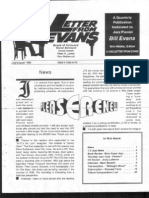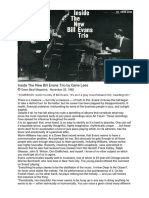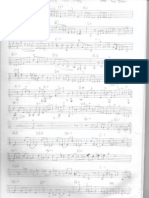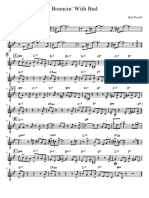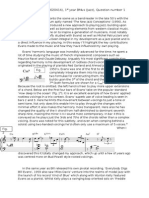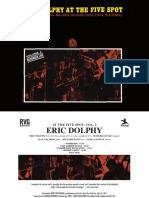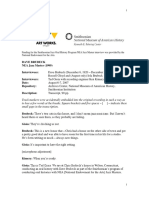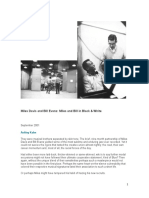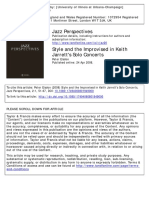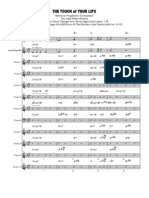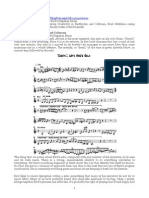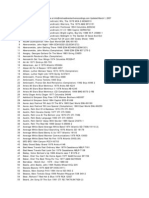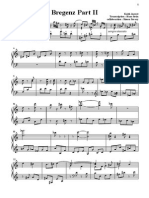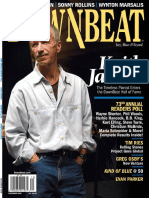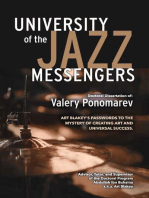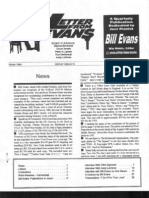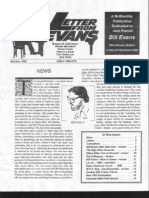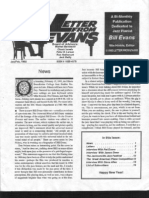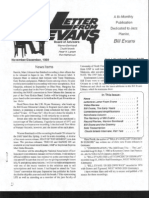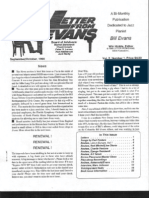Letter From Evans 12
Letter From Evans 12
Uploaded by
Joao RodriguesCopyright:
Available Formats
Letter From Evans 12
Letter From Evans 12
Uploaded by
Joao RodriguesOriginal Title
Copyright
Available Formats
Share this document
Did you find this document useful?
Is this content inappropriate?
Copyright:
Available Formats
Letter From Evans 12
Letter From Evans 12
Uploaded by
Joao RodriguesCopyright:
Available Formats
I
J ul YI August, 1991
Board o,f Advisors:
W4rrm Bernhardt Chuck Istaels Peter H. Larsfm Ron Nethercutt .Jack Reilly
A Bi-Monthly Publication Dedicated to Jazz Pianist
Bill Evans
Win Hinkle, Editor e 1991 LHT£R FROM HVANS CSCS PublicafiOlIs
Vol. 2, Number 6, Price $4.00
Henewal Time is Nowl $18.00 renewal rate in effect for a Hmited tlmel
base. 1£ sotnoone donates $SOO or more, he will receive LFE fot the lifetime: of the publk:atiOll, all back issues, a copy of the BiU Bvaas discography (when rep:riIItW), anydesigmttioD be wishes in my database (e.g .• "'OreatExaJtedOne, ft) and his name in Wg'1: print In LFE. Don't write off your contribution asa charitable donation tmtil I got: the non-profit stams, If LFE earns any money after normal expenses, I intend to set up a scholarship fund and/or purchase 81. burial headstone for Bi11 EVl:wfs lC>'lting place in Baton Rouge, Louisiana (peodl. ing agreement with his family). In a future issue, I willist subscribers" names by country so all may soc thecompaay they keep by subscribing to LFE.
As LFE enters its third year, your renewal check is elltretn,ely important, Ifyou reaewbefore September I, 1991., IDe rate fur 8J regular bulk mall subscription is stiU only $18 .00. U.S. funds. All subserlptlen prices will go up September 1, 199 J; so yO'U win save. if you renew now. 1be new mtes arc
on page 14. If YOIl ate a starving student or a persloner on a 0 Larry Whitford of Raleigh, North Carolina has started II,
imed Income and cannot afford the $18.00, write me a'OOul newsletter "dedjcafed to Chet Baker and his music," Cher''s
vour plight and I'll see what I can do. Choice is a qua:nerly publication available for a $20. annua]
. In the past. I've had only one subscriber contribute morerobscrl.ptlon fee. When the premier issue arrived in my mail
than the subseription fee. 10 addition to the price of his box. I oooldn or put h down. until .1 had read it from cover 10
subscription, he sent a check for $50.00. I have never begged COYeT. Larry has some ableasslsrance from two other edJitms,
formoney, and Pmnor going to r,!!!!!!!!!l!!~===!!!!!!!!!!!!!!!!!!!!!!!!!!!!!!!~~~~====iI- (one in Ni,oo, France). For more
start now • On page 13 dlere is at ' In "this Issue: ~nform.ation, conract Larry B.
"State of 'The Newsletter Re- Whit-fom, Chet's Choice" S 814
port" wiitb some flJl:ltICial infer- Rene'waf Notice . . . . . . • • . • • • • .. 1 [)unbar Road, Raleigb;, NC 27686,.
mation, By September 1;. 1991, b - F- 19' Phoile (9Jl9) 8Sj[-4422~ FAX (9'19)
R9nawa/~S'u .sctiption .00m • • • • ". .
i hope to have nea-proflr SIa1Ul. s, S b . f' D f 14 ,85 1- 89 68. (Chet Ba ker fa IlS
it.- Nflw 'userII' 'OIl na~ flS ." • • ,. • •• '.
I will accept donations and gill:!j t Should enjoy Hal Galper's reml-
LFE fl I h- Naws . .. . . . .. . . I' • I I' • • • • • • I; • " f Ch • t1. .
to keep ." .a. 1 oat. a,v'e mSiOODCes 0 ' .. ,et-ln i.e UUCf\I1ew
thought about having different Correctlons ••••.•••.••••••••. 3 I with Hal in this. issue.)
levels ofsupport like symphony Letter. . • • • • . . • . • . . . . • .' • • • 3 In the fjlSt issue of Chet's
mcihcstta.'i and public radie sts- Thoughts' on Jazz EduCllfion-Hai GaSper 5 Chol'ce Larry priareda picture of
lions. bu l tba t docsn" t sit "'How Deep ,;$ the Ocean» - Jack Reilly • 8 I hiInself, along with the edhorial
slIaigbt With me. If any OM 00- The State of the Newsletter AddrsS8 • 13 staff. I guess I should print my
nates above his subscrlptien Interview with Jim Hilil . • .. • •. 14 piCl:'W'IC in !FE SO' readers can see
rate, he will have the desigtJa- Keith Ja.frott in South Carolina .••• 17 1 what I look like. On the other hand,
lion "contributor" in my data-
- - - - - - - - - - - - - -- --- - -
Ltitt9.r from Evans, July/August, 1991
maybe J shouldn't; I don't want to SC8l'£. anybody! Let's just say I fit the title of a jazz rune that a friend wrote" MOv~r 4'0. Overweight, and Ov;er the HiU,"
D 'lrus issue bas a grcat article by Jack RtdUy on the nme, "HOw Deep Is dIe Ocean," I'm no pi3llist but in order to proofread for the article I played Jack's six part veieings of Sill's manges on the plane, My fuurt.oeD.-year-c~d daughter was in rheroo:m listening and laughed at the 00'8 and ah's that issued forth from my lips as I bathed in the Ju:ruriant sound of each chord. Ir reminded me of an anecdote concerning two greatja.z:z tnllSicians in the area who get very ~cited at hea:ri1ig each Other's chords, espc:ci.aUy after ~1ll.01dng alJUJ..e too much controlled substance. 1he story is true, more or less, but has probably been embel!.lishcd a Uute. having been handed down by wo.rd of mouth from rousieian to ll'lusioim.
- Ii.seems that Don the guitarist and II. jazz bassist, blown affectionately as Dr. Rope ~ got a caD from @ local contractor to playa pool paR}' duo, gig at 000 of the major hote~s in tae area. They met over at: Don's house to gO' to the gig anrl partook of apre-glg weed to order to' clear up the old sinuses. They got to IlIe hotd. found the r001, saw a guy in a su]t and asktd lli when: they were, to-set up. He replied, "Just set up aJl:ywbere you like," Don said to' Or. Rope, "Yeah, man this is going to be a gr'eat gig." 1he:y asked the guy ill the suit .. "What kind of music do you want 'us to phliY • map?" The sui.tsaid~ Anything you want" So Don and Dr. Rope set up shop in the sm,die. and started playing jazz standards. caeh wow:ing the other with new-found chord substitutkms., havtng a great time. After an hour or so. they took a break and went back to the car [0 clear the sinuses a little more. saying to ,each other, whata veat gig this was. lheycame back to the /POQ'] and asW the guy in the :stl.it. "How do want IUS to work ~~ breaksT' 'The suit replied, "Anyway you want is fine with us." Don and Dr. Rope thought, "Wow, man, this is a great gig," Don asked if they could get a drink from the bar. No Problem. Don alJd Dr. Rope had a great afternoon, playing whatever they wanted and dearing their smuses back in Don"s caron breajs, After three hours Of so they packed up, Ilutir stuff and wenl their separate ways, .teOOtUlting what II. grca,tgi.g they had just played. The people around the pool thanked 1hem fDr pJaymg forthem am said they had really enjoyed the music.
Whe.n Don ,got home WiD the g~g there 'WaS. a «antic message on his phone ,answering machine from. the contractor. The diont had called saying his band haOO't showed up. It 9CCms tllatDon and Dr. Rope had a great :g~g.only they were ·ht the 'wrong botel!
OJ Just before, this iss.ue went to press, I It,rumed from a performance by ,the, Keitb Jarrett Standar:dls Trio art the Spoldt.o Piccolo Festiva~ in 'Cllarleston" SC. I aboint:ervlewedi Keith and bassist Gary Peacock I'Il print the-se interviews in a fUture Issue.
The conversationwith Keith prompted me to recall and reaffum why I publishtbis newslener, Keith expressed een-
D'/SCLAIMER
:~;tE:T;fEittfRd~ti3(Jj~l~}ii~:~~~,~@if~~~~~,~:~;;~!y~ti({;
~;:'t'''.~';~~~;;';':~;';i~~''b~,:.:,;;,··;''':~Tori~ra~~~~$20:00~Ib\JlkratEljtitf',
~:a a,n:'''''I~'t:UiU,,,,,,,: . "" ~~'! .', ,,', I ;"''':, " '" ,,," " ". , ,'}', ,,"
.!lffi.~;~~IRt~~ri}(~;~~~ff~I~~!.~~~~;~Hj
; ~,:,.~~", ~"n;;.; ~ ~'" ",' ~~); an ~Mh' <, ~ :':~'" ti" ".,~.; ~$35; lfuridS:; , ,MeXIco,' ;P!e: _1t~~ JOe:" >i!~" ~U,:rpU!1J~, 15., '0,' '\, ".",;
:2 ''<U'');';::d'i.i.ff '·",G<pu:.Xo'~~~4~soes':~ar~':~ava:!1a. tf
"JI1L ,; :.'.9'~~"","'~~~/;;;;'i/,:~~P~;:'t';;:;i!"'.:,"~t:,.:,,!,; :~,:t~,;;:,~ , "d' i.: &
FIB.OrtHcll V¥fot9.Igi1I):i!.;r;~er:p'p~'QtJ;~;~~" '''>~ ,.:f;
:fh ~ ~ ~ ~'. A: ~ :.<:' , i5~t~si~lnt '':1H6S9; ijfh,:PUbli$,~<i:irtE;'~Ii~: i
'~i:itrt!L~~~'!:"~':,:·~:~:~~,,:,,~;J~"'.:.:i;~;i:ih:r~~:~<;'c.;:.:i':":."~'f ,~:'KJIi' '~Y,Y!rr'H n'kla1~or'lhe,;~o~~:U',.I.:\~$On;:.~J;.O:;I"J9r~~w..:'"
~f~~{=i~~i:I~mffi~~1!ttA~Z$k~~tiJ!f
'f t~'&"tiriii!,"ta~Ei~~ldi'~~ BnJi~i\~:~i;~U$j~l}.A}r#Wi,: :;.cru:d;f.i$I:~~~~W~~'~6np.H!iij;@i~fm,ri9ri~~,Ojji,m,~!#~ri PS6i)' ~~g,'~ .. ' ,Bi'lf E~iij$ :hiiif~"tiiit$!m;a' \~p'i'~nq,otl~s; i :ffdr,:h~li~i::ftijhdili~icmXnlFj::!~Tti~!fi~~r,d~ti;ijffl!~~attQ,i'b
;;,6.f.~~~~JJ!~:~lU/~)ri.~~~'~t#;Wi~#!~~1:r.,~t~m~TI#fi~'~!;
:' ~ PUblishGt/~ditOr,; ~jhs;'pov.e.t Jogod?~~s'e~ :~Il: A: p~tll~~; ·!'~~~~·'n:b~';;t~1~~1.r"iSha!I<~<::d$sj"n&d~by~twHkli:Ni{1g'~
.. ~;~: ;;i:'~' ,,'~::' ,Volcs'Eh6tJe. (4()7)',618·i1.1~;:::~~~~<;~::,:.~~~: ".';, :"'''''''',;~'':'' 'pJf''' "011 'In3'231134B'''''h'';~: ""<,,:',
'ff~:;NNm!rHHf:if~;0t!l}jiii!f:iJi;i:\;HjfJNwitHJ{Hh:,r1/jffUiin:
The editor/publisher, wrlte'ts, and mfJm!xm~ •
oHbe' Boamol.AdvisOl's of LETTER FROM EVANS have' ns,ve, knowinglYllndorssd or
promoted any iJltJgaJ aUdio or video ttlcomings.
cern (as others have) that possibly Bill would not approve of this newsletter, I'm not sere either. and I never will be. LFE is both a tribute .and 8J service-oriented pubHcatioD fur jazz piano playing and trio praying as exempJffied by BiU Evans and othcts. After a major talent like Bill Evans dies. there is a tendency to place that peISMOIl a pedestal. I suppese to some degree, I'm gmlty of that and you are also, or you wouldn' t be tea.ding this. This publication celtbtates jazz piano playingplano playing as di¥ers~,as Ha~ Galper and Fred Herscb~ ,lames
. Williams and Keith Jarrett.,. JOO1U!e: Brakeen and George Shearing. Even after listening to fifty pi8D~~ts (lilre 1he ooes mentionodabove), I can cue npa 8m Evans CD-and find something eJl'se in Bill's playing tha.t: is unique. I'm always OOIWfi back to Bill's playing" This newsl~tte( is a 1n1mtc to that as well as. an attempt fa try to understand why.
Also, if you need further exp)aruiJnoll why rpnblisb, pick up a eopyef Down lkal'" at Jaqjz. I rest my case. At the o.tbe.r extreme~ if you're not reading Cadence, Jazz Forum, Coda, andJau Times, you're missitlg QUit.
o Don NeJsen, an arts and leisme wrlter for the New ~ork D~aily News, is writing a hiography of Bill EvWlS. Dan wwote 'the liner notes on BiH's first rocotdings and kept in contact with Bill Wlt.il his death, More details later,
Corrections
I gave an incorrect adcl!rcss for DMP. nighai Music Products., in the last issue. This is the label that records Warren. Be.m.karot,. Andy lAVerne, and many other fine musicians. In my haste to print an address. I reached for ,a DI\.1P CD and gave We old New York address, lbe correct one is: Digital MIJsic Products, Inc., P.O. Box 1.5835 Park SqUII.n: Slatron~ ShlmfbroJ cr 06901, Telephone (203) 327-3800r FAX:(203) 323- 9474,
May 22, 1991 Dear Win,
rm .in a rush preparing to leave OD the 25th fur rehearsals and perfomumces in Yugoslavia with a fine Soviet pianlst and a good. Yugoslavian drummer, We will perform at the Lisinski Hall in. Zagreb on June l lth (this performance wiU be televised), and then go on. to Gerri!any where we have II, concert in Smtt~, ali the 14th. and then, several days of recordlng in ludwigs.burg., All this underthe rubric of the Chllck Jsraels lrir,ernational Trio. Thcoi go on to SpaiIJ for some work with Steve Brown and Barry Harris. Anyway, I cootdn"l leave
without taking a moment 00 thank you for the tape of the BBC broadcast. It is great to have this visua lremindcr of our work togelher as wellas all the recordings. Besides, the perfotmances. are first. late. and you were right about the ql!l3lity of the bass sound on the tape. It. makes me fhlnk I sbould have kept mat mstrUfllem!
I do think you might tty to interest Bruce Ricker. I'd cenainlly be pleased to have thisgeocraUy available.
I'm enclosing a copy of a letter to Down Beat that may be of interest. Meanwhile. ence again, ~any. many thanks.
Best wishes,
Chuck Israels
BeUrngbam. W A
I haw sent a copy a/this excellent Vide,a. Jazz 625. made for the BBC. to Bruce RickerQj Rhapsody Films. This is the company that offers many fine jazz videos i"cbuJing Bill. Evans: On fhe Creative Process. If anyone could do a goodjoo olmaking this video come"daUy ,muilabJe it is lJr,ll«. I will keep readers informed {it is made available.-Ed.
May 22, 1991 DoWll Beat
180 West Park Avenue .Bmhurst. n, 60126
Imagine my surprise on finding a CD released 00 lEAL Records from Denmark 0'[ a coaeert oflhe Bill Ev.!mS 'Irlo in wbich I performed (along wiith the superb drummer. l..arry Bunker) at the Maison de la Ra.dlo in Paris. in 1965. It is ironic to find that the usual waroing against unauthorized copying appears on the label of this unauthorized plratereeordlng, One of Bill's compositions, "Time Remembered," is Ugled as "Peace, Piece" (motberof his compositions). The Ilnecnotes, byone CharUe Gamer, tnention ••• "the support andcompUcily of Wlo great partners, .... 'ibe most sensltlveenes Bill Evans ever had. "1ben the liner lists Eckl!i.e Gomez as rue bassist and Marty Moren as the drummer (somcthin,g like mixlng up Ray Chadesand Stevie Wonde.r or Tony Bennett and Bing Crosby).
Ir is possible to be glad. that the public has access to a recording of these extra,ordinary pcffurmances~ while dcplor~ mg the shoddy way in which they have been released. I look forward to the opportwrity to meet the people responsible for this release, so that I might have die ehanee to air my feelings to them, Meanwhile. this forum will bave to suffice.
Thanks for the chance to shed some light on a nrorky situati.oo..
Sincerely,
Chuckh.1aels
Bellingham, WA
Since I don't Mad Downbeat I don't kn(Jw if they prillted Chuck ·sletter. It is reprimed here for others who may not read Downbea,t.-Ed.
Letter from Evan,s, July/August. 1991
1 JUlIC 1991 Dear Mr. Hinkle
Thank YOll for mailing out the isswls of Leu-er From Evans - I find them fascinating readi!1g.
Apparently many of yOUl' subscribers arc like me. and do, aot have Larsen's Bill Ev<!tiS discography. I had "Written off to Cade.Me for a copy one time when they advertised it. but it waS out of stock by the rune my letter reached them. Sadly. Mr. Stu (00 the West Ceast), who specializes in. Jazz Diseograpbics~ cannot locate a copy either. Hopefully. a seeood edition of the pnblicarlon will be issued someday. I see you from time to time m. LF E have eommented on the demand for this; do YOll have any idea if or when it wiU come ,aJ;,ouf?
In the meantime fOr my OwP use, I am working on an aJbum Iistillg, drawing from anold Jazz Monthly dlsoography, the la]Xl.~ nm: album Iistiqg ofOcfober 1990, Wa!lter ~ and my ovonrecoIdootlection. J:..ar.;cn'sdiscogm.phywooJdbemuch,easier!
I ague wholehe.artcdlly with tID:: poHcy of lFE with regard to unauthorized issues of ,artists' works. At the same time, recognition must 100 made that were it not for the likes of Boris Rose. Jazz record coll«tors and studentsof the artist concerned would nat gain fuller inslght into jazzmen, such as, Clwlie Parker. Europouljazz concert ~ almObt "as olright" briQg in lheir OAT 1f:oordeis and! tape concerts. 'These tapesevemualliy eeme out 0tI unauthorized records, or Blt dw very ieast. eirealate through MC[llbs, .. and from a second 'or thitd generation copy> the pedormance 'wiml.;; up in the record market
Evans devotees are still awaitfung the Warner Bros. release of the [as! Village Vanguard sets. Are we to be denied these because of a bureancradc wrangle? All tlris is a preamble to say that, despite being a pirate release, the A1fa eight CD issue ,ofEvaos·s last Keystone Kemersets is one that deservedly is available to ccllcctors. It offers those who, never had the opportunity to hear Evan.~ in person the chance to· ]is.teD to" SU«'eSs10fi of baslicaUy unedited live sets. The sound is not up to studio standard but LnaU honesty, when sining in a smokefined club with the attention Level of the audience varying from totally imme-rsed to totaUy indifferent. with We clank of ,gl:mses. and with the movements around you, is the sound to you in the audience any bel'ler?
The ~eyswne Korner sets gi'~ lIS the 'opporrunity to hear how Evans structured his performance f:rotn night to night. This is one of the few examples on record of this, Even the Art Pepper Thursday through Saturday Vanguard sessions Cf!J. Conternpo:rruy proved, en release. not to be what the jackets stated. Apparently the record company sbuffled the sets atOlIDd 10 suit their "programming."
Anyway. after all that, enclosed is an analysis I made of the complete AUa set ,arranged accoeding to tunesplayed, In a]1" twenty-four runes wetc played wet the eight sets- "I'vly Romance" six times, MKnit fee Mal)' F. ri five times, for exampie. Of m.ore interest is the fact that as the .co,gagement progressed, the tunes became slightly shorter. I haven't <li
metronome to check, but it does seem 1hat be increased the tempograduallyas the week progressed" rather tbaJiJ. reduced IDe number of ehoruses played. AU in all, I n:g.ard this full sc'l as being as on a par v;ith the flrst Riverside Villag,e Vanguard sets. and, is a great final tribute to, Bill EvaiJN. lIDis estate should be paid by Aim to clear the record,
Regarding your comment in LFE Volum.c I, Issue 6, on Denny Zcltlin performing ~Quiel Now;'; -Zeitlin recorded! it solo on Living Music CD ill (lOll "Homecoming-DeWlY Zeidin ... There is on recording dare, but the CD has a publication and copyright date of 1986.
It is also of interest that, muing one of the sets on IDe Mfa CD's. BiU Evans makes apologies for the late stan; of the set, and refers to the fine playing by me inrermisslon piJaIl.tstDenny Zeitlin.
Kind regards.
Wellington Choy
Auekland, New Zealand
Mr. Choy's Jetter is veryinte.restiltg and' raises some good points. First, 1 wi U address the possible reprinting ajTum On the SWS, the very complete di.'lcography 0/ BiU Evans's recordings by LFE lJoardof Advisors member. Peter H~ Larsen. I 1uwe a copy oj Peter's book. I must h(Il1t! purchased it just bejor'" he. rWl out.of ,copieJ)·. It's a wlJIJ..tifuland ,exhaustive work,; complete with some photos thar are not available QlIy~ where else. Presently;, I'm in tlte process o/typing all a/the data .into a 'word processing formatjor pos.sib.le re~public.atio«. Whel,1 and if I decide to do this, 1 H-vll indude. regardk.~ of their legal SfaJU.<;. as many newly released BUl £van.s recordings (as well as tribute re,c.ordil,lgS O)! others} and pr,ivate tapes if the .owners want them inchlded in the publication. 1 ha1>-e yet to talk to Peter about this, but 1 intend to have a ,(mIMel with him andto pay him a royalty on n~1)' book published. I have been toying with the concept 0/ ~ on demand book publishing, .. a concept initiated by computer gu.ru, Don Lancaster. In .this procedure, there i.o;: nO mrnim,u,m ,(Jr maximum M11I.'l" ojoooks to prin.t or the 71:eed to enter i71tu WI)' legal. contract with a pu-blisher. TIU! se/fpublisher needs a rom· puter; alaser printer, WId an me.-p.ensii.le mlUiiltg s),s1em or .neighoorlwod book binder. Taking about an hour or less 011 a laser printer. e.ach book is prjnled 0'11 order.
Secondly,. ihe slateme1!t about European conce n attendees regularly bringing tn their DA T "corders 10 tape eoneens almost "as of right ~ inno way ju..)'tijies such an iUegal pnzctice. In th« past; I too have ken g.i4iltyof ~(jkmg a tape recorder into eonc:e.rts. I don't 00 it ,now •. 1 ,used to dream :up elaborote schemes mplacethe m,icrophones in better position, such as. bliNding a pair of eyeglasses with tiny electret ron· deltSer mila!s imbedded in the earpiece! Als'o J used to hook" my Sony TCDSM i"f.W a hamess in the small of my back. People would look at me and think J ~us die hunchback of Notre Dame with weird gla.sses (and 1 don 'r even wear
g/o..tses). Half the 'time these schemes didn't ';1.Uril:; plru [found that I ~ 'f listening to or e'TioYing the concen, because 1 wa.'i worrying about how the tape would come Qld. Al home 1 had this ii"UW'iw coiJectian a/tapes that Lnever had time to listen to.
1hls phase of my musleal life is over. Now I tab a qualitative approach to Listening rather that! quantltative. I still go toconcerts andattempt to record everything, only now I do it with my head. In can find some light, I do take same written notes. I tnay want to remember something in particular for a
. review or a certain clwrdsubstitutiol1 or jUst the h:y:!>' and tune ti'tle.s. I might hear some obscure standard ,that .1 tit:m .! know and I'll write down the title to remind liij'St!lfto wok it lIP' when I ge,f Mme. Those who. slIulggle tape machines into' concerts s.hould notjiJrgef that the musiciallS ore creating the music on the stage, (11" in the club, to li'mm to; The audience' has 1tQ rights (atlle r than listening) to the music, especially reproduction or selling the performance: jO'f profit. J'axz m.usicians ooly gire away listening rights ,o/lhe time Qf the per/ormo.nce. If one isn 't capable.' oj takmg it all in, in Qne ;sitting> then he should bu.y a CD and not come to COJ1:cerlS. .The ilJegt#, taping is gelling so o.u.t of i:UJr;U/. that I expect to see COncert attendees sign MUliers. which assig11S triple damages for copyr~ght infringement, or to see ~"ecut'iry perso'1"1:ei with ;,;-r-ay maehine.s set up at every entrance.
Sun, the AVa Keystone K(J!rl.lu re.cording gives a glimpse inta the Bill &U11S Trio'playing. in a club without the "programing· of rectntl companies. Ofteri this ~pmgramtng" is ,often done by the artist himself. Bi.ll Evans had the right to let his Wldicn:ces hear what he intMd~d them to hear. r es, Mr. Choy, 1 can understand ho'w ihis recording can be a greol experience fo1' you. e.\pu:ialJy since yo« live' in New Zealand and n~r had the oppommlt;y 10 hear Bm at a live pet;/orm'Qllce. 100nly heard BiU play live once,' it »'as in ,a terrlbk dub. under terrible circumssanoes; with ,almost no audience. ,(Ewm a noisy huliffimmr audie.nce is belter than no audience. The likelihood of getting paid is far greater.)
'Th rnl~ ... n· fi~An '_!L...!· ~.~ '1:". I e 1. .......... ..:'61!!i pure _.. . YSII1JII!I!j1ty ru p!'t'SQtlS~v-'
ing or deadi_:umpanies, or actual fw:h: is pUl'ely coincidental.
Let's talk about Tom Bat,gain and WIl Winner. Tom is file former owner of Cornerstone Comer. the famous jau club in San Francisco. Wit Winner is the owner of Spe~Wess RecaRlS. alarge, fairly well-respected European record company which may or may not have ties to AJ.pha Reeords in Japan. Many people have assured me that theiris no truth WMHO" ever in. the foHow.ing hypotheticalsltuation. For the sake of argument, iier's assume that Blll Evans lflade an agreement to let the trio be recorded at the Cornerstone Comet cngagt.fiient and gave or sold Tom Bargain all righUi to thosetapes. Tom BargaIn sold, or somehow made avallable, tapes of ~bose performances to Alpha Records. The tapes are released! Oil Wi] Winner's EUropean label, Speechless Records, and au Alpha
in Japan The A1pha oompWlY has no eemmuaieatien with Marc Johnson or Joe I.aBatbara or Nenette Evans. Regardless of anyalleged previous arrangement with Biil E-vllifiS, the actions of both record oompanics. and Tom and WiI axe SLEAZY at best. I avoid dealing with sleaze. No matter how anmctive:ly packaged, no mattet how badly I want what IDey are trying to, sell. they sinrply have no right to sell this recording to me or :myooe else.
[End or .Fiction Section]
Now we can look (II things from the record producer:~ perspective. What if a cillb owner possessed tape:!>' o.l1d a record company offered a smaHsumtopurchase them? 'J1iesum M'OUld be smafi because the income Pf}umial ftom a~ artist of limited appeal would be negligible. What if the pro~r at the .record company ~mply 'wanted wsell the record becau:.$e he liked the artist and ('{)nsidered him a.'Orthy of TeC(JgllilUm.. Do tire ~lafty ~ rn~ of the record company .someMw negate their responsihilit;'to clear perj'ormanCl! rights lYith the' mu:.ieians involved? Unequirocaily, ,the answer is oo.-Ed
Thoughts on Jazz Education
by Hal Ga~per and David Udolrh
this is an interview with Hal by one tI bi;l fOl"lllCl" studl:nls, David Udolp,h. LfE reakrs shou1dfilu1 tire srJJjed nUItkr We,.. csling.
WI thlnkit \VaS Cl'Lkago," says pianist Hal Galper as he taps his cigarette out .Iligainst the inside of the glass. MJI was playmg with Ohet (Baker) and be was singing a ballad, The place was really packed and everyone was quic,t" As he remembers the scene, his voice; cernes do'WJl to a whisper. "You know ClIefs into soft, .00 I'm cornping wi1bmy feet on the soft pedal, hamly bitting the keys at all." He smiles and motions with his hands in the air, ntiming the chord changes as if he were on tiptees, "Evetytlting was fine uatll I hit that one chord. a little bit too loud. Then Cheljllst stopped He turned around and SCICam~ 'You Got m· I mean you eitbtt learned how to play soft. or he was going to embarrass you, to deafu.ft He laughs but you can see the picture is still clear in bis mind.
This was the real school where HaJJ Galper says he learned his email 'WaS in the heat of things, playing behind bsndleaders, such as Baker, Sonny St]u. and CWIonball Adderley. Trt.ading wat'el in the deep end, the real world of jau. Where people demanded thai the music sound tbe way they heard it and nothing less weuld SUffICe. With Chct tius fun,e. the lesson was volume control and drama, but mere were many othcr lessons Oil the road to experience. And they all come with
Letter from EvansJ July/August, 1991
~t.ories .md maxims, Uke. little devices tlIi1.t glow with the revelation of scripture and keep the wisdom of the music alive for 'the next genera.rion. ntis is thelrue method ·of jazz education-initiation and experience. This is me way it bas been since the very beginning, when it was stlll the di.sFCPllItable folk rousie played in the street markets of old New Orleans.
While this oral tradition is' by no I."cans extinct, itgradllally has been trtltWorl1leil, asjau. has ,achiewd more respectability ,05 a • seriOJlS· mU$lc. Over the last twenty.fwe year.! in particular, the oral tradition ,has been subordinated within rhe academiC' ,community as a romantic cliche • which 1)pifies the oo.IOlfol history o.f the music-more a l?t.5tigiail1lyt'iwlogy fhalJ a lISefol metJio.d lor learning how to play. WlUle the prolife.ration of formaii.t.ed lllli'lusity-kveljQU programs has done much to validate :the artistic l11legrityo/fhe musk in the public eye. it also' hQ.~ distorted some of lh.1!! trufhs :that lie behh:d the notes. A:sj.au. becomes mare homage. nizedwith the times. it/aces the .dangerofl'osing tfJu.ch with Ink; perso~ab'piritthat sti!lsllrv.~ ill the al:u.doteso!the experienced player~.
Idiscussed this problem qf payi'ng your tuitio» rmMI' than paying your 'dues' with Red Gaiper. A dedicated fe'Genu jor Q).'er t1Ve'm:y},ears, he aJfored a .Imique perspeclive 011 the prob.lems thal the ja'lZ. instrllctor.!ace and he provided som« solutions. He also spoke abou.t the deficien. des common to university music depomnents; which seem to chum Old players who often are more t.eclmica#y p.rofident titan expressi ... ,ft.-D. U.
DU: Oneof the primary diffioulties in educating people for careers in the arts is ttying to come ttl, terms with what can and cannot be bl1ghl. Any kind of cwative activity 110 ultimately persensl and demands a certain amount of origiuUly. A ~het must work within We parameters di.ctatOO by the talent and potential of the student. In jazz, the important thin,gs you leamaren't passed along like famous dat,es in history class, It's more a precess of self discovery. 1fI this ligbt, then, what are the benefits of a fonnru musiceducaticn.
HG: It's true,a_ny art is baskaIl!y a self-taught process. No maUethow much education yOll have, 1be final result is a1ways due to a process of lrla] and! error-'working 'lbings out em your own. Tbe value of a good education is that h gives you away to teach YOUlS'elf. A good teacher will ceaehyouend make sur-e you are on direction, In this way, you can develop a good disciplined, logical approach for your own way of playing or painting or whatever. A teacher teaches semeone how to leach himsdf and then keeps track of hlm to meke sure be is using d:te process correctly, Eventually this all beconIcs ingrained and automatic • and you use '!his system for the rest of yom life to learn any new inlonnatien.
DV: St! teaching is necessary?
HG: Ye&, absolutely.
DV; You don''t think it'sju&t as good to learn on your own, wilhout any insttucnoo?
HC: There's a bask built-in problem with any art. No matter what the medium, there is always a projccrion of an illusion. If you are learning solely from observation (listening to ~Wllc or leaking at paintings)" you are subjected to the Illusions that the artist is projecting. and you truly not learn what. is going on behind dIem. The cOOt. or sldll that makes the art work is not mways read]]r apparetlt. A good teacher can :show you what goes on behind the scenes. He can help reveal an the assumed processes thatare only alluded to, in the work itself. And these are the important things ~ know. since they are what giIve the work its logic ;md ~ttength-the 1Wngs that make it projcc,t in rue first place ..
DU: But it doesn't have to be a formal ~catiol\ does it?' It. could be like Ohadie Parker listening to Lester Y mmg when he was with Basie+-an infonna] appeentices s hip.
HC: Well, you aren't picking a very good. example. You're picking Charlie Parker, who happened to be one of me greatest musicians and had the greatm.1 pair of ears of anyOl!J.e we know of. Red Rodney has admitted tome that lIS fur as he could fi,gute QQt. Bird didn' r know theoretically what be was doing. Every time someone would ask him the chords for a bridgehe would say, "Oh, ugh, 'I Got Rhythm,.M He was not that thoroughly educated-at least not interms of the Lnformatiofi t!ha.t is a.vailable today. 'This bdngs up an interesting point. Vifha.t kind of lUi education are we talking about? Are iheredlstinctions to be made in education? I think there are. If you are fucky enough to have ears like Otarlie Parker. great. Btu what if you're not? DU: So, you think talent is a valid eonsideratlon, or is le;llroingjazz ninety~n.iJne percent perspiratioa and. one percent msplmtion 'l
HG; You ha V~· a formula there that I think varies from person to pelSon. I've seen sixteen-year-old kids who had greO'!r time-feeling that it would rake otherpeople fifty years to' learn. Yet their notes weren' ttegether. And then there are others. the same age, who have great notes, but no time, So there ~s no bared and fast rule heee. Everybody has: their own strengths and weaknesses, and it is the j ob of the teacher to POlrit. them out. It's coaching ..
DU: What are the ways a teacher can ,contribute to the psychoiogica1 development of a playet? O~arivity lUllSl be nurtm:ed roffocdy. and certain environmenrs ate more productive than others. What can a teacher: do to, bring out the best in II young player?
DC; In order to improvise jazz, a person must be relaxed and ineemrol The ideal creative attitude is ~ p~ayful-state-,1;!hc • child-like. oon-caring. non-goal oriented state of nUnd. We had h :all1he time. when we were kids but itwas trained out of \IS. because it's so unpredlctable. And society wants nioe, safe • predlictable people. Creativity is a threat to ,this. Even your own parents arc afraid of 11. 'Ihey want to see you develop habits and patte:ln"! that iliey can understand like doing your homo.
Lefferltom Evamor July/August;, 1991
..
work every day. So, we have been cendlnoecd oot of being ereadve, The good teachercan help bring the student back in touch with this childlike sp.irit, by gening him to relax and mot weigh down the creativ:e proce.~ with unnecessary psycbo .. [og:ica.l baggage;. All nervousness and problems witbphysica.l and emotional tension mbit the natura! flow of rue music. Th.e teacbershould encourage the p]aycr notto take the ml.l.Sical penottnance too seriOl!idy. Basical.ly~ you 'cant' give a [expletive deleted} about how you play while Y'OQ are playing. There is simp]y no rune • .and it restricts you.
DU: So, criticism and :self~judgm,ent come after the, fact'l' HG: Well. yes, blu even then. your ap,prai.sal win be pool: and ioaccur.ate. Self-judgment is tcally a joke. 'The·Ie is no objective 'how you sound'. The science of psychoacoustics has proven that no two people hear ihe same way; so, all ju.dgnum.1s are ultimately opinions. Some people will. love lt, and some people witH hate i~ and it reaHy bas nothing to do with your level ofperfornumce. And of all the OPUUOlliS, yours is the: least valueble, When you are playing. you ate much too invol ved with the music to step back md judge. And even. if yon make II, tape of the performance" irs not going wsoond the same. People hear in a linear fashion; not in layers stacked on top of eaeh other. And diffutcnt pe.ISpeCtiVC& produce a comp,letdy different listeniing experience. If you are ~is,temjJ.g to a record, or w.alchlnga hand live. you are on the outside Listening in on the music.Whereas If you are in a band playing. you are bearing !.be inside of the music, the bare bones. Everyone is invol ved and reactmg to what is being played. UnfOrru.na.tely. people often sound bad to, themselves, because they compare how lihings soanded on the eape or record with how they p1ayed live. But. these Me two differ'ent ways of bearing.. SQ. it's a mistake to worry about how you 801ll:'id. DU: Wt> seem to hear a lot about all these young musicians ooming up with exceptional ability. Do you 1lhink a lot of 1hls. can be traced to the: current sr,stem. of jazz education?
KG: There has been a loot of talk lately of an tI:lese great youl1g cats oomillg up. but :I think the press is m5mpttsenting the reallty of the simatien, There have always been great youtlg musicisns corning up. Paul Chambers was playing with Ivnlcs when he was eighteen; Tony Williams, Scon Lafaro, Clifford Brown. It's as if th-en: were never any great young musicians. DU: Well, a Jot of the attention is due to the fad that this generatlon is: choosing to ~-examine the acoustic tradition of the music, as opposed to joinitng electric fusion bands. How~ ever, :I a.gr-ec. iliat tbe hype is ,slightly unjustified. Tod!ay's younge,r musicians are v:ery conservative and are .trwre concerned with preserving the identity of the musicthrut in treading, new ground. \" et all the players they revere were artLo:tic. radieals-eoriginals. The people who write these articles often fail to mention that while these young players have assimUated a ttadition and havcleamed to p.lay SlylisticaUy correctly, someone like Clifford Brown at the same age was inn.ovating.
HG: Yes, but I:here are very few originals .. Thefalntcst hope of aU i8 to become an .innovator. Moot of us are synthesizcrs. We have absorbed different styles of playing and, eventually ID_oougbthat, have. developed our own particular way. It'sonly the few guys, like Bird and Miles,. mat, are the mnoVllito:rs; Ahmad Jamal. These peeple keep IDe n::st of us going by contributing somethln,g really original and different. But even in the« case, it ruJ. begins with imi,buon. Tais is the true process: of l.eaming any art, You must copy, before roo can be original. Sotbere bH10thiog wrcmg with,going back to the tradition. Bu,t. basically all this attention is behind the times, because the movement hack to beJoop started about ten yean; ago.
DU: B.W. (Before Wynt:oo'l')
BG: Yes. Wynton's just gotten tbe credit for it. But. I bave been leaching for twenty years, and I see what's gomg on in the schools,
DU: Hastae liradition of the music been distorted ar all since it e.ntel1t;d die roainslreain1
lIG: Yes, These yonng guys are leaming the notes right, but they hav,en't got the beart and soul of h. It's the feeling of the music and what'sgoing on ~n between the notes that is hard iO leam, You can Of really Iearu jnsr from schoel andrecords. Reoords are only 8i djs:ti.1JatioD. of what's really happening. I leemed bow to play from. recoeds first, (00. I loved Red Garland; and 1i copied him as much as .I could. I bad II. teacher at Berklee who would transcribe solos on()fder, and I would IeatnRed's solosand chord voicings.andevetythlng. But when Rod! esme to town and I got to hear him in person. I had to change cv-erytbJ.Qg. AU tile assumptions that I made aoout his playiog were incorrect.
DU: Is this related to what you were saying about the differ~ eat ways ofbearing? It'sa different perspective forlhe ean;1 HG; Yes, but jr's more than dtat. You're not hearing reality when you're hearin;g a recording. because everything cannot be ttansmitted electronically. Emotion, feeling and intensity are not easily expressed, even with me mesr sophisticated reeordingequfpment; And when I heardRed in person, he 'Wl:I8 ::lwinging It:'11 times harder than I thougbt. he was. Rely1ug solely on recorded music, without catching the, pJa)'er's life, can lead to a lot of miseoeceptlons, The big problem I have bad with the IDyth:m]c aspect ofjuz over: the ~t twenty yearn is 1hat me beat. has gotten thinned out. because 1JeQP1e are leaming from records. And this is the main aspect of the· music that defines it as jazz. The notes are western and have been around for hundreds and lnmdreds of ycars..lt: is IDe thythm of the music that is so innovative. This i;g what came over from the AfriCIIO continent-the syncopation and thythmic mte:nsity.
DU; II is now the nineties, and jazz still seems to have a Jack of self-esteem abol1t it. Even the older musicians, who naV'e played it an their lives, still feel me need 10 justify it as a "seno'u.q" music. To what degree do y,ou mink all tile
hge7
l..9tter from Evansl July/August. 1991
emphasis on education is a pose 'of fashion-an ad. campaign forartlstlcvalidity?
BG: It is tru;e that there existsthis complex with tlJc D1.usi.c, and jau musicians themselves have protnotod dns attitude. Jazz came out of a very disreputable background. from. the whorelJ.ouse,s.1t is basicaUy a saeet musiclhat bas growu more and more sophisticated with the years. It is a basbltdired form, and there has always been a pressu.re to' ltegit:itniu: h. I rememberwe were pJay1ng aceneert with Phil (Woods) in Rowe once. and we were opposite Betty Carter. And at that time. we were aU dressing ~.leisU[\elr as possible. So here we were at rbe·ltome opera. bouse, wearing jeans and T -shirts, Now Betty Carter shewsup in an 'evemnggown with Ref band all in tuxes, And seeing \1..'1. she started criltidzing our dreSs. She said; "Y ou've got to bring ja~ up" -me perfect statement for this klnd of animde. "'Berry,," I Sl!id. ~Iwasn't aware it had been down." So, the music ,doesu'( need to be validated When you origlMlly saw 1he earlier generation of players become faeullies of universities, that was really done to give the music le gitlrnaey, And this is ridiouhms. A lot of the early musicians were well-educated musically. They smdled with a lot of d]ffereut people, and they kaew what they were doing.
DU: There's something so pretentious about. all this seriousness in attitude and in dress. n's almost a conspiracy against the fun in 1he music. Also, a lot of die players who made such a conscicns cheicc about gettmg their education in:ii. conservatory tend to overemphasize the value of reading music to, again. give jazz that edge of importance. But, if anythln~ it is a tn'bute to die subtlety of a IDll'lic, jf it can't be .adeqUately capmred in notation.
BG~ Well, all notation is an awrodma1ion-a suggestion. Even. in classical mUSIC. So, it is Dot a valid justification for considering one music any more diff:er,e.nt than another. There's no suoh 1hingas an accurate notuion. It can't be done. Real muslc exists ito. We imagination. and everything after it. i!s written dOwn is subject to interpretation. The true test of the artist is how vivid is his lmaginaUon, nOit how wen he read-s: the notes. While It's always wise to study and improve yourself, it's bad to use a degree in music to justify the quali~ of an art form. This msrlhltionaJizing of the teaching of music in the utdv,ersity has been 'one of thel'llOSt deslnlcti ve things. Ftom 1900 oil jau already had a methodo]ogy for learning how to p]ay. but it was not considered a legitimate proeess, ~Pakiog it .. had a nega1::iv,e. eonnotatiea to it. Yet it's just another way of saying "'using well trained, highly sophisncated. inner pnx:essesto compose music freely on the bandstand. H' We"re allrfakers," and. eventually you learn how to, do, it so wen that DO one knows you att: doing it. I've been faking for thirty-frv,e years. but I'm. not going to reU anybody. I'm going to go up there and pretend that Ilknow what 10m doing.
DU: But if you arefaking, then you really don't know what you"re doing; it's just an appear.ance.
HC; The word Mk!:!OW" here is very important. There is: more than one kind of knowing. There's knowing where you can name things, and there's a more ]lJtuiti ve kind of knowing. Wl is fhlis kind iliat is so important. to pJayii:Jg jazz. Usually the intuition and the ears know ten thousand times more thmJ, the, intellect ever will. So, the mere ability to name things is DOt such a valuable kind of "1no,wing."
DU. Yet there still exists this prejudice against iostinct and intuirion.
HG: Yes" case in point. I knew a great bass pJayer m Boston who played totally by ear. If you told hlm to playa chorus of blues, and, you dian'1. give him the lI:OOt ofthe key ahead of tiJm; he was lost. Bm: once rou gave him that .F or Baflat. he could play anything under the .!OWl. fi.nal1y he decided to come to N.Y . and give it a ny. Ehu after ;I while, dUngs didn't work out for hlm. He became so paranoid and iotimida.ted by aU these schooled players. Ibcy knew the namesof thlngs.,andl he dldn' t, and he thQught that dds was :50 impc:nant. The sad irony hefe is dud he was a meehbetter bass pEayers than most of them. You don "t Jrnow bow many times I run into players who confuse the importance of a dteoteticM ba.ck,groundwith knowing how to play intuitively. They are beillg misled by the wcs.tern, classical approa.clJ.lo leaming. There is a most importam methodblogy for teaming jazz that is distinct from this tradlden, and Walt is 1he ,African way -imitation, ,copying., and sl1Idyrng with amasier and playing in a group. The master tells you, ~Makt it sound like this," and he p]llIYS something on the drum, and you copy it. And then you go play in a combo with othe·r musicians, and the master supervises youtpcrformance. This is completely different from the western mode of teaclJ.mg, which is held in a classreora, and hi entirely out of context witb the reality of playing the music. When was tlu;, last lime you saw a classroom in the Village V anguard '1 That was my classroom.Tbe preblem with westem edaeation is it's analyu~ 'cal. It breaks things down to their smallest pieces and puts them back together again,likacar mocbanic. nus ls the complete opposite of the African ine:'1hodolo:gr. which deals with thiogs as a whole. Y.ou are always in context, You are always wOf1king wi,thio sound of the music itself. You are very organically involved with it. S-o when au African hears a group. he bears one sound comprised of different components. Wbe-n a westerner beatil a group, he bears different compotlents that comprise the one S:OWld. It's a very lmportant distinction in attitudes,
DU; So, does the western approach not apply to jazz?
HG: I'm not knocking it. It can be used in eonjunctlon with the African methodology, Imltatlca is very one dimen~ sienal, But by learning how to analyze things, yon develop the freedom to expand on what you cepied, and you can understand ~t on a deeper Jewel. Wbat I object tois tWs -, ovetemphasis of analysis, It's much too fOmJal and academic and is virtually useless on the bandstand. Knowing the music theore1iicaJly is go.al~O'riented. but knowing how
L"ttet from Evans, JulV/Augustl 1991
toplay istllogleal andplayM. The Afticantrad.iti:onisanoral tradition. Western analysis should be taught.as an adjunct to this tradition and Dot the other wayaround,
.DU: To what do you attribute this imbalance in our system of educatlon?
HG: 1be:re are a lot of vested interests in teacbmg, and people ru:e making a lot of money at ~.1lJ.CrC are thousands of music departmems in the U .S.,;md a lot of people aremaking their living front teaching ,the notes and ,theories rehind the
. music, But, you' see what these people don't realize is 'that aflything you can. wrir,e· down QU a piece of paper is goitog to be the easiest part of the music to leam. And it's also going to be die smallest body of infomLill!tion. Tbe:re·s so rnueb mote tha,t caimot be, written down. that can only be [earned 1ihrougb the experience of playing. That's ftc largest and hatdcst part of the music. You can't buy h. Usually you get paM for it, You get paid fur being a sideman lin a mod. and! you learn, So, these academic teachers have a vested interest in. stringing out the. easy pms of the music wd making them appeatdifftc:uh. I CIlJl teach a peeson it! one year an tile theories they need to know to play all1he genres of jazz. It does not take four y,ears to learn all the easy parts of the music. It Laikes fifteen or twenty yeatS to learn aU !be hard parts.
DU: What do you think of those play-along records they sell? Are the y usefu l1
HG: Nothing .in itself is bad; irs in how you use it. As fat as k8l:'tting repertoire or practicing ideas, tbe r,eooi'& ate it great tool, However, there are a lot of young musicians isola.trd in small towns who end up using the records as a subsdmte for. p]aymg with Uy,e musicians. This is bad. By doing this, they doa't learn fie most important pan of 1begroup experience, stgnaling. 'They are learning how to play isolBtied" and they think that when you go play with it rhythm. seetion, you JilSt '"put them on" and play over thefil. I can lell. in eight ban if a snrdent has learned to play from. these records. Yon can. t,eH. because libey don't listen. 1bey don't know how to interact or respond .. Jfyou had a computet that eeuld graph out the lU"IlOWlt of signaling that goes on in a top level jazz group in the first eight bars of a solo. the paperworkweuld flll this room.. II: is all :signa1ing. For example, if the aha player wants a oe:rtam chord dlange behind him. he "ll spell out a particular scale or a. superim~oo chord,:so that piano player am ClISmon the line Dh the appropriate chord. It's a group experience,
DU: So much of the le8m.ing process is simply p.artk:ipa.ting in the mw.de as much as poss.:Ilde. .H this is the 'case; then what is the value of practicing?' What can you hope to, BCoomplish.1 HG:: You are pr;epariug yourself to pLay. Tbe pr'll!cticing of the music, Is eartraining, The playing of it is going up there and using wat 1:ll':aJ.ining. When you are practicing. you are training yo~[f on aoinruitive level, You arc internalizing the rules of rhythm" harmony and melody. so tMt when you get ttl '!he bandstand, you can make up ideas that follow those rules .. The reason those rules exist in the fuS1l place is because
dley create the strongest possible muslcal ideas. Another important. thing about f'l'lcticing is that you are trYing to eultivate an under:staodling of musical. relationships. You work through variouspattems and ideas and the differeDt components of the music withtb.e hope that ~iI.tua]ly you will begin tocomprebend the big picture of these relationships. There is no snell thing as an isolated event lnmwdc.lt. is only an illnslon, There is a direct iClatioosrurp between the music of Arabia, Bach, and w,hat's going on today. Their apparentisoladcn is only due to a laek of pereeptiee,
DU: What would be your "dream school?" How woold you fur.m..aUze tire oralb:aditioo!
HG: Wen. die SUzuki. mEthod has [egitinUzed learning by ear. Finallyl Irs proved that you can leam music by earwitheut 1m.owing a damn tWn.g about what you·reo playing. Butoveral], mest scboolssre using the same iDadoqnate methods. I have been tea.chlng aU over the world. and I have seen the SlIDIC problems time and again. There's Ilot enough supervised combo work, and there is DO' large-seale acceptance of the Allicao methodology .. I would like to see a school th,a:t is less fonna] in the classical sense, but just as forma] in ii's own way .
Most jazz edncatien today is being destroyed by the pr,ofit motive and the ,accredited universities. As long as these dUllgs Me a prerequislte fur a person's education, you are going to have an overloaded currieulum and acceptance of music stu· dents woo are loading down faeulnes.In most of the schools thal I have beea to, the ldds don't have any tiJne to praetiee what they are leaming in the classroom. And they don't have It chance to play enough. If a peJSOO!J. goes ito a scboolto learn how to play. then he'd better gel that chance-not a place where you get a piece of paper at die end. And it won't ClOSt tell thousand doUam a year, and it won't ta kt: IoUI' years.
DU: Maybe we need music gailds-e-the apprentkeJrnast.er slmadoa.
KG: Yes. People can hide in the classroom. You can't take the time that's needed to show everyone how to playa. scale. Also; group dynamics takes over, and people become more inhibited. Y·ou know guys ask me, '"What school should I go to T" I say. '''What's the diiifeICli.Ct:, they've all got the same probJtms.... I teU them not to go to schoo.]. U I had forty thousand dollars and my parent's trust, I weuld take that money and really learn, I'd foHow bands around and listen to theme:v.ery nigbt r d buttonhole- the guys and g~v~ them money for lessons and advi:ce. I would get my own group to,gethcr and rent rehearsal space •. 1 would get equipment and make tapes, ] would hire the best ntl!lSidallS: who were ten times above my
Please send your RENEWAL cneck NOW!
le-ftG'r from Evans. J,uly/Augus~ 1991
EX. 1
H_DW Deep I s the Ocean [A] ~HarmollY by Hi II Evans. Voicing'S by Jack Rei tly
iii I I I I I
C " I
--
, ,. - I II
, ,I
-III! , Q""' ~ to ~ '~c. -E -t': I
"< c-,+7 A"U Dq,lHI3 Gn'9~13 (;1111 IBlo.ll A~~91>13 D7~5l>9l>1:.1
(, ~n s- -(r ~n n
. I I "
. ' .
I ·r.
,
\ -, -I ~ I I ,- J
( I , I
, -
I
- I II
'- '1E .,- l' , "I lit.
PM,9, 13 [plI" H3 A,,~9H3 D7~S'+5~9 (;1111 C1+S+tl filii 8l>7+5+9+tl
( P. fJ- _J!@'_ ~, -~ ~ -n
'I
I ~
I' I
~ I
I 1\ I Je .Il= _l
(': .~ I I
-
- ,
I I I
~ E~9+11.13 B9+11,13 B~·U E~1~9+9~ 13 Al>13 E-Il [l>.lt A~13
( [9- L.~ ~- L cr) (r 1151- ,~~~ ·bB- ~
· I I I'· -
· - , - I
I, I I I'!I J I ~n .II L.
, I I I " I
I - I ,'.
, ru .,
f --
IJ "I- i -, ., 11"
1 C#lIIU r'B DIll 'F7+5+9+tll B~ .... 5+9+1]l ,,.,7" 91~ 13 n ~9+9.13, G",+-9~U
,~n .Ir~ X~ J.'I~ 'I ~- -~~ III -~ 11')
( I':;;:
·
· .
• I
-
, , Pilge JO
Coda [CJ
I -1.
~
P'C
Cn9sudu Cn5~,9
n riI
• II
I
i1'L
A~·u ht
I I." If
t
D~'hUI I ~~
E~9:uls
,~
~ I I
r~ --I : I I L =r.
I I , -It. ,
11.' I
, t ~' pc;
~ E~lIlj7 G1+9~9 c-9~1l fl3 '8',13 B~9+5,,+U E~6j9 Gn5t.9H3
~ -~ ~ L~ Ie- ,bo- -(J- h,.,
I rr I
~, I I
,I , ' I
- I
I I
I
, r I : I 1 - - iy ~ ]IC " , " Cade,n, c"e M, ',aga, _z,ine, &.
I Record Sale
- The Place to Find IRe'cordsl ~e stock ove,r 700 labels ~~om all over" the world and1,00Qts of different recOlrds. Wha,t WEI don't stock - we carl
oftengl'B,t!F or15yearsweha vaprovidedtothaJ azz ' rsee rdBuyerthef in ests 9rv iceattheb 9S tp ri cas. For aee m p'lle te ca fa 1,0 9 U 9 P Ius th ecu rrent iss ua of Cfl~ denee Ja,zz- Magazi,ne s9'nd $2.50 to: C,a~ ,d'an'cEi M agaz irnEl, Cadence Buildi n9 I Redwood. NY 13679, USA. phone 315 2e7~1 I 285:2, Subscription: $25 outslde USA:$SO
• AJ!B;'IDIl irM;IMld lin iaz;;I. iIiIemIalionall)'? Ii '1119 _ $W!I" is )'eS. L:IiI8!III )'OU, sIWI:I ~1::i$C:Iibe to JRZ FORUM', IIrI!!iI bimaitt'IIy nnagazin!I eM 1tMt lniIe!i'liltiOnaJ ' JEW: F~, II crfIBr.I a unique 'pe~'8 from
I lop 'I'I1'iters and ~ amulXl '1iT!e ~IODe, 1n:!m_Argeo~na 100 y~_ Staned In 1965 JAZZ FQl'illil is 1MB ali '1J1!Jl1y i~ jazz ~ne, ~'s 1he ~ fa' p~ and lans,aJI:B, filled w'itI1
I news)W'~ use-
• JAZZ FOilUM,'s IrnemalkinaJ edition is publistled
in Eng!i5!i aMI appeen;i blnoonIhty-s1lt limes p;;!r~ear, The t)B$t ~ 001 til miss a @'fis to~, OWl it soo. ~~tion. whictl 'jI!'.tI can (IQ ~ t'IfI~n 'Durfdillo- I i\1I Office in WIIrS!fW', PaaOO. 0!.Ii' RIWI su~ ~ wi! QuararrtM a.fasi Mi'I Rent ~ lor rsadet:!; around !tie world.
~~I]OIUJI,H;
, '~E!.QIIiII: IJ,S,S~I!OO {~ 0'1 SIIUlO (!:tulm ii'lall} ,
kI Arnmu. ~da Imllliilt oI1htl ¥l'oltl :U-S_ S2Ilro
(~ m.ail, S25i.OO (Jiimsl). .
I ija ~I§ ~' .... b!e 111.1 'l'fIqle~ !tJr$a,O!J pl!f COffl'$f.ni'p':IIJf~'~ lVfpajlTOOlllinWio:aJeCI;« ,~~Moosy 0!dIr io'_ j.UZFQfI\IIii.~~,O!l-695W~.,~,
1HE~OIfnIE !NmIIIP.1lOroW..u.:zz~DQH,
he has created. Through the use of inve~jons. he passes 'from c minor (3 flats),. measures 1-4. tothe region of g minot (2 fiats) in measures 5·8. :m measures 9-16 (l.etter 8), Berlin HSIeS four sec:ondmy domlnams. This is another stroke of genius, for he creates just. enough teasion to avoid another tooal center-a brilliant contrast to rue restful wnkfeeJbig ofl.ctter A. utter B works its way back. to the V7 chord of cminor (0\ preparing US for the exa·ct .repetidon of Lener A. In Letter 4 meaSWll~ 25-32, Berlin settles ~ burt this time passiflf through F minor (4 flats), (m.eas. 25~28). and .concluding in. E major (3 flats). (meas. 29-32l
Take a 100k .ait the chorda] breakdown from 1he Berlin original piano chan jnE:< 2.. Let's compare immtdiatdy Evans's chordal chart in Ex.3. Thls ana1ysisooincIdes with my voicmg realization in Ex, 1.
My comparison of Berlhi's orlgim] harmony with Evans's reharrnonizaden is; to remind mysdf that a composer's original score, u:;.'OOllr the published sheet I1UllS.iC. wi]] a1ways reveal the gcni!llS, if it's .tI:refe. Great tunes were great runes before any jazz player reharmonized them!! r A composer worth his salt win never, never rebarnlonize his own runes. A great song is conceived in its entirety; that is to say. the melody, harmony. pulse 0'1' meter, bass line, and mytthmic motifs are heard in the creative masical ear and mindsinudtaneQJlSly .. IfyOD can't JJeU it aD. asonce, you're not a composer, and you shculdstep down. ~oni:zation is not meant to change theeharacter and! pemonalJ.ty ofa great mne. Substituting di.fferent chords is not what I call reharmonlzlng. When I rehannow,. 1i. enter into the mood (also the mode) of rue song. This us1i13lly wkes. ye<ll:S of playing IDe tune in the original form and key. Rcharmonization should enhance the melody-make it stand out rome. Reharmooization should make a celebration of modulation, the arrival of a new key center er region can be. explored a 1hoosand different ways. and it aever, repeat never (if done with ·taste) destroys IDe compeser's original inrent. Therein Lies the secret: inten.tionality. To be able to dliscem the composer's mtentiontakrs great hlWlm~. but also oompleteknowledgeof a the past. And J don't mean Qfily knowledge of the American Popular Song; I mean also knowledge of Western Classical Music. There isn't a progression in the jazz. litErature Of the pop repertoire that. hasn't already been written m classical. music. The Usn B mlnor Sonata covers seventy percent of aU ptogr.essions found in mamstIream jazz ames,
Bill Evans Dever changed a metody note to accommedate a s.u.bstitute chord. I read artidcs in Key;00ard Mag.aziDeaoout SUbsti1utiOlliS and rehannot:rlmtions, and they read like: klinder-
gartea theory texts, toWly ignoring the mood of the song, .~
BUt's fehamlooizauoo of "How Deep Is The Ocean~ is a tour de fOl'Ce. I:k enriches LeUr:r A by surt'O\!lJ!.ding the tOllaUtiesef c minor (meas, 1=4) and g minot (meas, $.S) with ~ diatonic chords. In Letter B,. he creates more tension willi chromatic secondary sevenths. And in Letter C, he higl.llighlS tile arrival of f minot and IDe final resting place. Eb major, with
.Letter from Eva.ns~ July/August, 1991
level to play with. You see what r mean? H I had that kind of money when I went to music school (which it dido 't cost then). my caree.t could have developed much quicker ..
Six P'art.V.oicing Concepts by .Jack ReillY
"How Deep Is The Ocean" (Com:~ by Jtving Berlln) (Re:hannolIizarion by Bill Evans).
This is an AA' tune. It ill vide·s itself into 1·6 + 16. adding up to 32 measures, Another way to look al1ihe form is to tIUnk in 8-baT phrases:: g + 8 -if 8 '" 8. Expressmg this division in Jetter symbo.]s. I come up with ABAC. 'Ibis. is a mem preeise analysis and :seJV·es as .3 mnernooic devicclO ~isttheiInp,toviscr in memorilziog the. progtessioa, This .isllot a tune for a beginaer in improvisation, cspociiaUy when one COffiJl'31'CS the original harmony with Evans's tclwmoni1.8tion.
The song begim in the by of e minor and ends In the .relative majOr, &fia.t If you have Ii copy of the «igina} sheet mosic. you'll discover that Berlin usesenly one chard pet measure for most of the 32 bars. IDs ge<ni:us [ies in IDe bass line
E.X.2
Cmi I em; I ~:~bass I Am7b5 07
Ibba~
I
Gmi I Ginl /Gmu 1·=-b7 )oioiio.
, 1# bo!ss Ab bass
Eb1 I {Ab7 I
. Cmi7b5 I F7+6 I Bb7+6 r G7+6 I
, Coda
GmJb5 lC7b5 \Fmi I Abmi6
I
Eb I F9 JBbi' I Eo
Elb bass a bass NOW IS THE TIME TO CHE.CK OUT THE I.A.J. R. c ..
The I ntemational I\Ssociatf.'OfI of R'llmord Collectors has bee'n providing com man grou nd fol' record col- . lactorsof all styles of jazz for m ore than 26 years .. Annual dues are $20.00. Sandlfor yourff\aa sarn-
. pie copy of the tAJ.R.C.Joumal. IA.J.R.C. Mem~
. bership Director, cI·o Vic Hall, P.O. Box 75155, .
Tamj!a, FL 33.60S,JJSA. I
Letf9r {TOm EVlIfU:. July/August, 1991
Unichmm Productions and ~ present ,Internationa'i P'erformance Camp for Jazz Pianists 1 Jack Reilly" Director, Win Hinkle, Co-Director and 8aSS!1,st-inw_Aa-sidence Dates: Sunday, June ,28th to Satuf\da:y, July 4th, 1992
I ?lace:. Union Oollege, Scltenectady, New York
, TulUon: $32,5,00 for !)eIifOml8rrli'Sl'licipanls (ftc1tallsts). $180 .. 100 for audl(JU (Felis 00 nol indude room and board or privatll'leS60I1ISI'. Pelifolll161"$ must senel acas:setl.e 'ape (~S-m;I11lil& onty) o.f~~alrpts Ih~ inlllOd to play an tille ~venll1g reQlaI in PfO(llll1il order, At lem one Bdl E'IIIIIS compo51,tum nwsl ,be I ind!lded on !he program. 'The recilal $'hi!TI be l,imlt8lllo 45 ml"~:te5. Tape d~ad&nEl is r.t1rn:111. 1 i1.'!12. To
gUiuanl8ll ,admission, 8udnors should ragisler 'NI'ly by s;end,ing, 8$50,00 ,d~sll payab'le to. UN.1OH'ROM PRODUCTIONS, P.O. ScI,; 15D-243 Van Bmndt St:Mn; BrQCIt!I~", NY 112Ui.
EX. 3
'1 Am7b5,!l9,b13,
Cmi9"*7 Dm7b5.11,bt3 Gmu11
m,billlt3, BIlmi11 D,l,b5. b9,b is
Am7b5,11
Gmi+i,9,13 Al'l'llb5,b9',1l13 Gmi"11 Fmi11
Em7b<S,1 ~,!)13 OJ, b<5, +5.1l9 cr. ~5.+H 607. +5. +9, +11
Eb9. +111,13 Bbmitl Atl13 i::bmi11
139. +11. t3, Ebi.b9.+9.1:3 Emi11 AIb,n
C;IIm'i11 Cm71;i5,11 1307. +5,+9, +11 D7, 09,4'9. ~".3,
FIH3 F7·. +5,+9,+11 A7, b9,D13, cr. b5,+9.b13 Cods
Eb9:SU$ OD9s.IJs
cz, b-9.susb13 CI, b;5,b9
Fmi9 fimi13
Abmi~1 Do13
, B90, 13 Bb9 ...
Ebmlljl G7,'I'9,1i>9
Cmi9.11 Fl:l
Eb 619
G7. b5.b9.D13
.110 t~: TO_{;} c.tJdflge i s for fir.$~ t::,:'Q bE?~t$, bQ~t~m cba~'1VC Ls fer .l.cst two. A1.J /Jdlf dill1.L~iS,~~-d· cbords er e ,(,j.!1ta't.edF .i!li.nc.!" SG'V~!'J!:ll:.o t.1,~~ fi.ve I':. e A,-m'7.b5) ~
srds before he touched diem. Jack Re:my e Unichrom Publishing, Co. 1991
The State of the Newsletter Win Hinkle
With the mailing of this issue. LFEfin~ ishCSi hs second year of p:ub]icslion. I thought I shouM inform readers ilOOu! some of 1he mundane facts ooncerning the news]etter aadexplain wby I publ!ish IF E 1heway Ida.
Wh1lt
!FE is a leX.t~based. bintoruWy publication with editerial emphasis on contemporary jazz and jau piano playlng, espedaUy as influenced by Bill Evans.
Prirna:ry emphasis also is given. to the art of jazz trio playing,especiaUy asinfluenced by all of Bill Evans's Trios. Secondaly emphasis Is on current. traditional, mainstream, third stream, and avant game jazz, possibly influenced by BiUEva:ns and his contempo.rarles. It also may include: jazz education amcles on .aU of the above.
The pubUcatlon is primarily text·ori. onted witb SiIJ eceasional graphic. The reade'li'Smp consists of many professional as wen as amateur musicians, I tty to include a transcription or an edacarloaal attide with printed music in every issue.
Subserlbenhip
Presently I in~lilout some 370 lssUCS bi- 1JlOI:UhI.y. About 330 of 1ihesc go to paid subscribers. 'Ihe rest are (;('ItDpltimentaty
~bscrlptiQPSIo ad.viso:ry board m.ernbers, members of Ev:ans's family and close friends, CItbec jau maga:z.m,e ~ (with whom Inlay or may not have a tecip:rocal sub9:riptioo ammg.emeat), and various mo¥ttSand shakem in, the jazz w01)ld who I d::rll!k wou1denjoy a oo1lrteS)' issue,
Of the paid subs.cribers.a'oout ninery are not inthe USA.
LFE is pub1ished in one language other 1lhan Englisb-Japa.nese, Tbe Jap@iJCsc editor is Wil1iam MOJl!t'gomery of 1h1.')'0. (His address is Ilsted in 1he masthead on page two.)
I woo1d like to flad a French I..anguage editmfpublisher. I have some Engtisb4o-Prenchttansladon sofuvan:: (for ruM
both chromatic crobclUslring chords and diatonic approaches to Berlin's, original score.
As;b:.~part voicing attangemeot 'of Bill's masterpiece was me only format I could ~~ to fuDy jil\Stify his reha:rnlooizatioo. 'When I practice this chorale reelizatien of "How Deep," I alwaysbave the i'edmg" "How obvious .•. Why dido't J thlllk of that cJb.ord in .measure25T
We have a lot teo be grateful for.' BiH !Evaru: left us many Ibe-autiful compositions, but also many beautiful renditions oJ ID.e great standards. And don·t forge.1!.tbey were great stand-
PlIg,e 13
letts,.flOffl Evans. JutyIAug,ust. 1991
and compatibles), if needed, and can help with otaer ;support seeh as graphics and layout and design (although this needs to be endemic to the particular OOWltIy). The French publisher would make bisewn decisions about frequency of pubHcation. size. sUbsaipt:ion price, etc. He would have access to all files from the Bngllish ed~tion (in. computer format) and peanlssien to add other infw:matioo. The other language editions could be considered franchise. If W1yQ1IC< is interested in publishing and diis~1mrlng in other languages" caUme.
Income and C:apitaI Expenditures
My adjusted annual income for LFB for 19'90 as reported to, the Internal Revenue Service was $156 .. 00. I spend some fifteen to thiny hours per week working on LFE. I've purchased some equipment inerder 1:0 make the publishing of LFE easier. I own aK:onica/Ro),al 1790 photoc:.opier. ,a genetic mM oontpatibJe 286-12mhz computer, and a Hewlett Packard .IlP ila.'!Cr printer - [with an outstanding Joan of $13(0). Futltre capital expendimres iodude a luger bard drive fur the 286 CODlpukf, an additional 386-33mhz computer with 8 meg. RAM: and a 300 meg. hard drive or larger, and an electric fhree-hole pooch. I presently use three-hole pr<e-pWlchcd p8i~ per. If I switched to regular paper and punch the holes myself, I could save about ltd'! my present paperexpenses. I would alsa like ro pay writers and contributors on a per/piece basis. This: Fall , should acquire, non-profit status fur LFE. I never have soliditod donatiens for LFE. but st:artin:g with rue next subscription year, I will encourage h. lo the past. I have mce~ved ooly one giftfot $50.00.
Mo.st of the production staff life mem.Oers of my family.
Paid staff include a ~'is1 and proofreader. Other 'I!han that, the publication is produced 'entirely in house.
The fol1owing subscription prices wiH go into effect September I. 1991.
Subsrnpti:nn Categon~
Reg. Bulk Mail USA Subscriphoo$20.00 Fust Class USA Subscription $25.00 Canada 1hlrd Class Subscription $25.00 Mexico Third Class: Subscription $25.00 All Othc:,r CoWlmes Sllbscription$35.00
AU subscdbcrs who support: LFEwith $10 Of more above thclrreguiar subscriber level will be listed in a special section, I've recently purchased a scanner and will be able tobavemore art work in the pUblication.
Please remember that. without your support, LFE cannot continue.
ChefJs Choice
• ~Ll!i'b!irly ~'<J ;!&d~ ID 'Chl!t ~r MCi his nlln!~ Sublt~tion, $:201'00,
Larry B. Whitford 5014 Dunbar Road Raleigh, .He 27686
(91.9) 851-4422 Fax (9191851~68
hge 14
Interview With Jim Hall
by Ken 'Dryden
Condi4:cted by Phone 0111/1/90
Ken Dryde~ L'ii.ajau. radio program mer forme Public Broadcasling FM station in Chattaoooga,. Tennessee. -Ed.
KD: I heard you with Ron Caner in Atlanta last summer, mi Yeah, Joe Pass was on I:h.at bill, •.
KU: II was an il:ueresti..ng cootrast:, watching rite two of you. 1t1rst. Joe PasS\. a man of peq:>etuaJ motion; then you play'ed so' .softJy; and barely seemed to move!
JH: I've known Joe a 10015 time. Before the ccneert, I said, "You play fast and ru play sliOW." And we kind of have that agreement.
KU: Many people have, caned you laid back; and from th.t Cbarlie Cbristian scboel, How did you get started p'laying guitar?
JR; I grew up in Ohio, and 11 bad an Uncle Ed who p]ayoo the gultaJr. SOllI- ofWil1k Nelson..,type stuff. He pliay,ed and sang eouorry-westeen tunes. and that was dIe fust music that I beard. 'Iben my mom got: Ole a guitarwhcn I was: nine or ten, and I Just took regular lessons.I got into agtollp when I was in junier bigh school, when I wll:Saoout thirteen. I guess. And then I heard Charlie ~,tian on ~oord. and h·s weird to say t!Ws. but it really changed my life-just that one afternoon in a record store and hearing Charne Cbrisl"ian. I knew mat whar~ ever it was that he was doing, I wanted to leam bow to do. And the nice thlog about it isth.at I just reoentlygot a CD of most of the stuff that Charlie Christian did with Benny Goodm.an. and that Irsoonds even better to me now than it did when I was a lid. So it's okc to know that my judgment ~ ... if not accurate. it was eensistent. So that's how it started. Then I went through aregular music school, The Cleveland institute of Music-, for five yeats. And I'm soU piugging away at it.
KD; How did your style evo~V\e'1
JR: It's probably a runny mixture of bavin.g heard Charlie Cllristian and Lester Y oung, I particularly like Lester Young's playing. I've listened to a lot of ,saxophone players, so that I got interested in roelodic players earl)' on, as opposed to fast p]ayers. Yetthat's DOl really a oon1ndicrlon there, they're not rcaUy 0@Ip:JSed eotirely. When I went to music school, I did a lot of writing. 'OO1IDteIpOirnt~ analyzing scores, ancl getting a more CQ1Dpos:irlooa] approach to. music. And that seemed to stay wiith me somehow, so that wlwl I still do in a 00.10 is to try to make a little OODlposition out of it" and have the parts: related I imagin¢it's developed into· astyle. Also. I rhlnk that aetbeing afraid of space is important. j love dte way Miles Davis always used empty spots in his music. Also, I'm really interested in painting. scu]pture, ,and probably poetry a oh too; so' I get infIuen.ocd by things other than music.
L~tts' fr.om Evans, July/August, 1991
l
KD: You mentioned using space and! playing slowly and lyrically. r guess these are so.meofthc 1ihings that ntadc you SO cemparlble witlt Bill Evans during the several sessions you played with rum.
JH: Yeah, we seemed to havea really good rapport; II was a ~at period for me doing those things whh Bm. And I had already been iinfluencOO by Bin's p.layiog by the time we made those records, We found it v'ef)' casy to piay together,
KD; I was very pleased when Undercurrent was fi.mUy 'reissued with all 'the added e:rua takes. I don't see bQwthey chose between the two versions of "My Pmmy Valentine." It's II shame both weren't issued initially.
TH: Thanks, it Was fun 'for me to hear thal I had some memory that we bad done exI:m tunes, and a couple of faster tunes man were 00 the record, I think MiiCk Goodrick or somebody told me that there was another version of "My Funny Valentine,," so when I finally heard it. it was really fun to listen te it.
KD: Jar:. Guitar, yoW" frun aUrum as a leadet, was recently reissued. It must be a bit frustrating, seemg it all chopped up~ and with one song missing, Isthis typicaJ of Dick Bock's produ.cing? Wby would he shonen me SOf1gSf
JH: I'm not SIm, what happened was it esme out as a trio record originally, A few ye-31'S later, I can "t realJy say wben, he relisslJoo it with a drum overdub by Lany Bmt.kcr, and he shortened it by taking out some of Red. Mircbdl."s solos. Ana I hated that version of it. Fl.Ilaly. I €ound a eut of an origintai versien in Japan. I think maybe Dick 'Somehow thought it wou~d be m.ore commen:ial or saleable with a drum added, maybe it 'WOuld swing more, But that's an .a wfullhing to ask a drummer to do, because the time feeling is just different witb a trio. And 00 the CD I have. maybe it's been eerrected, it claims to have two versions of "1bings Ain"t What They Used To Be." It's really a chopped-upversion, and the same version witb Red·s solo included, So, I think somebody goofed, on the CD I have.
KD: That's V£ty unusual for- Michae1 Qlscun.a; maybe be couldn't find the session log ...
,m: Maybe. I' U write hlm It note. ..
KD: fm surprised that ClliiCUQa didn't findla dean copy of dJe oigmal LP. He did that With We Pan] Desmond recording of "Susie" that was loaned to Playboy fur an anthology and lest,
,m: I'll give that a listen again and see what's acrualiy missing. I was happy that it came 01llt, and as, a matler of fact, I find I'm able to listen to that record as If somebody else dJid it now. I don't cringe anymore;. I kind of enjoy l!istening to it .KD: All A.cross The City was an intriguing album, because you found someone who could use the synthesizet ;80 briJ]iarntly without overplaying it Is that what first atrtacted you to Gil Goldstein's playing?
JH: I think so, yeah .. J was kind of branching out a bit from the m.o format; J worked the Vanguard a couple of times, and
Max Gorolonwanted a largergroup than the trio, So. one lime I did it witb BUI Ftisdl-two guitars. a bass, and drums, And then Bill w:ru.'1l·t available at the time, and I had played with Oil Goldstein just a ]ink bit I knew that he had so mnclJ. experience using synthesizer, h_e·d done it with Bill lEvaru;' band for such a long rime; so he seems just to use it in a tasty way. So. I pretty much give hiim freedom with ·tha~ and we generally discuss what kind of effect to get On "All Across ThE Cityt I describe it as sort of a. "down in the dty." with things md.of waldng up a til'lle at a time, so I t:hlnk he tried to get the effeeten d1e record.
KD; All the reviews I've read seem to agree. It was so rate to hear a synthesizer played so JyricaUy. without clouding rhlngs up.
JH: 1'bBit"s m~~~ting" because I've be<:otn'e more aware of what you just said since doing '!be record and listening ~ other albums where everything sounds l!ikea, synthesizer. It wears thin very fast for me,
1m: I enjoyed W~ string session you did with Pau~ Desmond (Desmond Slife ~ reissued as Late Lamem).
J]I; Oh[ do too, a lot. ]I have :tcaUy nice memories of tillIt. AcruaUy. we recorded the quartet flrst on some of the tracks, and overdubbed the strings, One time, Paul stood behlnd a cUriam, so he wouldn't leak om;. I guess. And then Bob Prince wrote around what we had done; it was eat]y ov'Crdubbing [laughs].. I like the records, and Bob Prince was a close mend of Paw's, and had a special. feeling for bis playing.
.KD: It's interesting to note that Desmond ra:re1y used a pianist when he wasn't playing with Dave Bnibeck. It seemed be was mote oomfcrtable with semeene Jib you or Ed Hicken oockin:g hlim. Did you find this to be ttue?
JB: I haven't really thought about thair.1 wasflartered nanirally to be on the dates, but at the sante time-the same- with Bill !Evans-Pau] was a elose friend of mine, so it didn't seem qUlle so unnatural, especially after we bad dam::· 'the first one. And, Ihaven't really d10ugbt abourhlm not usmg a pi!lllist. He played the piano h_imsc]f, so I'm sure be bad special ideas .ilboot what he liked. He was careful about writin.g eur the chord! changc:s and the- bass parts. I n;cOIfimended Ed Bickert and Don 1bompson to Pall]~ because he was gom,g to tout and ~gilbout some musieians, :1 was bllSY so, :I told him about Ed Bickert. He was really hesitant t.o tty him [almost langhing], and tlten he came back ftomthese jobs and be was just mving about bim; he bad lots of~ be bad dane. So yeah, I'm sure he was very plcIq. And I think he smmds especially good with Ed Bickert" because of somezhlng about 1he way Ed plays chords, it a1m.ost sounds IIilre a PD. only a little more delicate. KD: Some of 1ihe more unusual sessions y;ou've done· were the several that you did with John Lewis, The WondeifUl World of Jau, ~'t!nee ~ and Jazz Ahstrac:tions. Vlhat was it like woTking 'With Eric Ooipby. someone more associated with the free J 322 movement'?
Page L5
- - -- - - - - -- - -- -- - - - -- --
le:tter Iro.mEItB.ns~ July/August, 199"
ill; I've just been listening to The: Wo·nderfo/. World of Jazz rerendy; Ijust found a copy of it in a stare.lliIre Eric's playing better now than I did then. On the Jazz A m.'tractic:ms thing. G'mtt1ttr Schuller's :sttdif. itflt well. Bur on some of the more usual thlngs, like MBody and Soul" for instance, 1I don't thlnk he I'layed on the record of it. But. I always wondered why John USGd Eric when Phil Woods was in the big baud, Eric was Ukt: raw material; I really loved him ar lot ~-rsonany. He was kind of uapredietable; and he would find tea1ly zany notes. As I listen to this stuff uoW'~ I think he's perfectfo.r those records, and he r.eaJ!ly loosens them up, just when they need loosening up [laughs], because John could be teall)' controlling. And I think Eric .reaUy fits in well on the Gunther SclmUer things. Let's see. Eddie Costa was on. some of taose tracks. and BiU Evans phyed plano, and I think then: wac two basses, George Du Vivier and Scott Lafaro, TbaJt was a lor of fun; iliat was a nice period for me.
KD: Tell me sbeut yom concerts 'with :MichelPettucdani. JH: That wasgreat fun. I bad never really worked with Michel. We had done '000 concert a few months before that; he had a series of concerts in Paris that W,e government helps sponsor, and I did one duet cotlcert with him with 00 preparalion,. <lIod it went so well; it was so easy to play with rum that we booked up this tour, We knew we were going w doa record with Wayne Shaner. and we had one quiek rehearsal wltb Wayne before the tour started; this wa. s up ill '~da-Mont. real. And it was a terrible rehearsal] Michel bad a. bad piano [laughs] i and Wayne thoughl there was going Co be a rhythm s«tioll; so we just: got arough idea of what we were going to do. And then. Mlcbel and I went. on the road; we started 1ills tour. So we played some of the materialon the touf; so we were a little mote famHiat with it. And then Wayne justjoined us at Mmtl:'eux,and we had about another bour to look at the SItuff. But the audience was so terrific in Montrcult, and I think that We three of us realizedtkat We had 'to get this tcCQf(l1M.t niglu ~ pa1ll.ghs] And we were detettnjned to mai:f: ha gotid one. So we just had a bail. I came off tbe sumd wringing wet; I practicallyruined my jacket.. It was a lot of fun. Wayne is a delightful guy. and so is ~chet.
KD; ~11't most of your dates recorded straight through? JB. They ate, yeah. A lot of times I' u take a take, even with flaws in it, if it has a good feeling. Another thing is just the time oonsideration in rhe studio, usually the budget for a jazz album isn't big eneugh-e-you can·t spend a month or .a ,year the way the rock groups do. But also, II think itbat stuff stanslO die 011 ~ vine .aft:eT about dlree takes .. So I usually like. to get it in one or two takes. and even if somebody screws up on the. thkig. I'd rather have dlat than go back and doctor it. 00 the Concierto album [reissued on CBS Ab.-sociatcd ZK 40.807J. there's one place where Chet Baker re.ally was scuffling with the bridge. Actually, it's. my wife's nme, "Tbe Answer Is yes .... And Chet was really funny; be refused to look at fhe chord changes) he Jl!ISt wanted to heat it. And they're rcany slippery
changes, so' he was scuffling wilhthat. And I went back in and overdubbed the guitar solo. We took OI.Jt about eight bars of Chet. BuUhafs kind ohare; usually I'Il leave stuffin.. ButBill Fmnegan told me he 8!DdEd SaiuteI' would go fur the take with tile best feeling. even with die big Qt1;:ihJ':sb'a, even if m~ were m.il'3fa1res or copying errors itl the parts. So • mose of my stuff was done pretty much the way ~t sounds on the recoId.
KD: Other than musicians, most jazz 'fang probably can't identify those ~dstah.s; uSlliBiHy. you all CQVct them up ~ny well
ill: Yeah. and that's what happens eaeoncens and in clubs. We did ail alib'unl called Live at Bou'rOOn Sireet [Livel" Horizon, A &:. M SP 105]. with Don Thompson. Terry Oarh:. and me. I kind. of ike that wbum; and Don aenallyrecorded it; he had IDs 'IEAClnil:chiooon 'lle stage for about two weeks. And Ilike the record, beeause lt' s relaxed But there aretwo or three places on the album where we acma]]y lose meter; 'ferry win ger apart from us for a beat. and then we get back together. So, I just wrote about ~t in tbi: liner notes [lIlIugbs]; I said if you miss tie beaton ;s;uch~a.nd-sucb. a tune, you'U fi.nd. it added 0l:l.W lliOO1:ler rune [I au gm ], bat c~ght or something,.
KD: Donalsc record.ed Paul Desmond under similar circumstances at iliat same rooati,OD.
JH: 1bat's right..
KD: Unfo.rrnnate]y. neither your album. or Paul's ,!I[\e available now. But yours should be on. CD anytime now. shoeldn' r it?
JH: Yeah, that's a point. I'll talk to John Snyder about that. I see John once in. awhile. Maybe he can pDt pressure on IDem. KD: You've composed quite. a few tunes over the years, Do you have a favorite?
JH; Of my tunes, oclld1y enough. I Iikc some of the, older ones; IactuaDy like ".All ActO$S The City." I think thafs pretty weU written. An.d llike the tune "Young One," wbk:h I wrote fur: my danghter. I also enjoy some of the blues l'v,1': wrinen, But taase two WOOS. ~ All Across The Cityn and"Y oung One," I think they're pret1y weU eemposed, The melodies have nice direction and kind of payoff g,pots in 1hem. And then I sdU enjoy playing "'Ca:reful. n which is kind of a convoluted blues, KD; "c.atefur is something a .. number of other artists have recorded, I think thatGary' Burton and Steve Swa]]ow did it [nme3 Square ~ ECM l-1111. a]SQ Hall recorded it with Burton, reissued as Artist"s Clw,ice~ Bluebird 62800 2 &8] So" that may be your most popular tulle with other mlllSiclans.
JB. Yt;ah, I diliJk BlllMay.s, tho piano plaiy.er, did .a record of it with Red MitcbeU. * And I did it: with George Shearing. but I was on that ODe. I[First Edition. Concord Jazz CJ 177] KD: 'The album with Tom lfatreU must have been a memorable date. [Inese Rooms. De-non CY 30002]
JH: ActuaUy. l like il.bat album a lot. In some ways lIike the sound of that record beliter than AU Acro~ The City. except that 1 appreciate that Gil was on that one. The A11rurn with
Letter from Evans, JuJy/Augusff 1991
Tommy wasfun, and I 'WIQt,e an extended piece C8illed'111~C Rooms" which I feel good about.
KU: Do YOil tty to' keep a library of ~vcrytb.ing you record 1 J8: WeU, rm ~1arting ro, I move aroend ~ much, and records have a, way of disappearing and gelling scratched. So. I'm starntlg to build up a llbrary now. But, I think in geneR1 I've been mere interested ~n the future than in jhe past I don't
- reaDy even listen to my stuff vezytnuch. Sometimes if I go on tbe radio to do an interview. rn hearsomefhIDg I haven' tbeatd Wi ten years, So I tend not to listen. to my own stuff vel)' much I listen mere to classical musk. orI get on a Jdck-l rea!lly like DonPullen "s playing, and I got Iris last album. I listen to that a let. But my wife and I are going to baUd up a CD libiaty~ so maybe I'u get ,aU that stuff on reissues now.
KD; Do, you have aoy musieiansin mind that you baWD·t. recorded with for fumre projects?
JH: Yeah. I do. I've been tlllkiilS with SiilFrisel1. and also Pal Metheny wants to do SQfIletl:Ung together, maybe a duet. I'm ttying to figure out what kind of format. whether I'll have diem both on the same album or whit. And I'm, also doing some writing. I ~13rted a piece fOf strings and guitar. So I'm hoping to keep plugging .lIlong here for theocxt few years. KD: I've sure appreciated your time today. We'll look forward to the next live date and your upcoming albums as well. Jll: Thanks very much. Talk to you later.
The above intervie w is fairly accurately !ran..\Tr~bed, with min,iitUll editing and corrections, mostly rewordi'ng my qul!S· tions! Some dated mate'ritl~ like Plans for 1990 concerts; is ,omitted. The proj.ecr mentioned 'Wilh Frise.ll and Metheny wa.)' probably the Town Hall' concert from Jane 26. 1990. Ul!for. .turrate(v, Warner Brothers refused to allow Melh~iiy'5 comributioPlS to be released OI! the upcoming Musiemasters release. Jim Hall & Friends" Vol. 2. Live At TownHaU.
* Mays and Mitchell recorded Hall's "Waltz New" on. their mrord TWtJ Qf a Kind. (ITI JI. 004, out of print). bot I haven't found a rc:cording by tbi.s duo of "Careful. .. I am checking with Inn Hall by mail to see iff such .~. recording exists,. or if 1t was a. mistakc.-KD
Keith Jarrett in Charleston, SC
Win HinKle
Charleston, South CaroBna. has the dobious distinction of being considered <l_TT!l.ong the threemost humid locations in the United States, along with Bloomington. Indiana and San Anwnio. Texas. It is also home to the Spokno and S]Xl'1eUQ Piccolo Festivals of the Arts. The Pic.wJodesignarion is fot .11
smaller, free festival, mnoing eoncurrently with the main events of Spoleno. Every day there are exhibits. eoncens.ballet oodi opera performances.
I found out that Kdtb Jarrett waspetforming at Spolerso '91 from a small blurb in my lOCSi] newspaper, The SpolctID Press Office offered procious little information about, Keith's concert, !I doubt .anyone mere knew who Kdth Jarrett was, I RoaDy called Stephen Cloud, Keith's ,"gent, and lesraed tl'tat thetrio was perfouning in Clarkston. (Stephen told me that Keith Liked my Ie,view of the StU] Lire double CD saying that I had hit the "nail on the head." This review was for another peblicaticn several years ago. StephentoJd me IDere was a good possibility that I could interview Keith sometime before the concert.
J arrived in Clta:rJeston the night before. The interview was .succes.\1irtl and will appear in a furure Issue. I also rl'tooght about catchlng a liIuuleof me local jau. action but decided against it so that I cooId maiotaio It clear palette. tnllsicaUy speaking ..
Reaikn shfJ.rJdbe a:ware 0/ the gre·rd interview with ilJ Jazz Times done by Bill Ml/kowski .in the JMe., 1991 issue, I suggest that £FE' .reatkrs read tltis be/ore gC1illg any juriJurr.
In the recent Iou. Times mte.rview Kdtb said that be wanted rus audience to hear him in liveperformances ami not solely on recordings. He feels strongly tha,t more musk barppens in live performaaces than on rus recordings.
Review
There was a good tum mn for the concert. but it was nor sold oot. The concert started twenty-five minutes late, because the doom were not opened until almost 8~OO f!01, the starting time, Hordes of people were trying to find their seats at the same lime. The theater management needs to learn mote about crowd control t
Kcilh's piano sound from 1he beginning of the milia to ~ AunmmLeavcs" to the last note of die encore, "I Remember Oifford, '", was beautiful. Keith is a master oflhc instrument (fle- played a Iilile-loot Yamaha ~d.} His range of colOFS is amazing. This trio eonsisteatly makes music on a high plane. Muskiilly I can find no fault with theilr perfotmance. The oely thin.g that I can do in this fOltnat 1S to list the tunes and let yOU! mow generaUy what went ,on. Voucat! never experience it. You had to have been thtre.lt wasnot recorded for re]ea.~. As. IdisooveR:d in the interview with Keith, the progmn orderfor theconcert is not predetermined
Kcith keeps a tune list in the top of the piano and may refer to it two or three times during a. concert, Keith will tell Gary and Jack the name of a rune, and then starts the tuaewith a. bead nod, or be win set up a piano-only intro,
Letter from EVans, Julyl August, 1991
The progtam order fellows:
• M Aommn Leaves" in g minor
• 32 bar bebop bead in F, up, unknown title (It sounded like a .Bud Pewell wn~ to me. In talking to Gary Peacock after the COI1.Cellt, ]I fm.md out that the trio plays the tune regularly but no one in the band eeeld recall the title.)
• "You're So Hard to Forget' in Bb (anice but simple ballad, which I don't know)
• KA steepin' Ike." in Eb
iatennission
• "All of You" inEb
• MI Covet the Waterfront" in C
• "All tlreTh:ings You Are" in Ab
• C minor fuok tune. J arrett original, tide unknown (by me). Bass line transcribed here.
• 3
r tv
• MI Remember Clifford" in Bb
Teclmically there were a couple of thlngs about Keith's 000· eert that bothered me. I draw attention to, them bere with the hope that dle powers that be arc able to do somelldng about them.
There are always balance problems when trio cencensare given in a cotIcel1 hall de:s~g[led for UIlIIDlplrn.ed. aceustic music. Drum set m:mu:facturers have spent thousands of research and develcpment dollars on designing drums with dynamic rouges loud enough to compete wi.m. electronic instrumenss, which are the nonn now. AcmIstic ba-~s and pianos can 't meet the dynamic levels ofloday's drummers. Yet drummers should have the freedom to pla)' in an ~bered mwmer" within the natural dynamic mng,e of the instrument. To require them to '"play with the:soft pedal on" ~s Dot fair tolhern. But as aresuk, the piano and bass must be brought up to the drum's loudest dynam.ic ]evtl williamp]iIficati.on whichremaias true to instrument's tone and sound capabilities. This is easier said than done. When the han b. &~-igocd to bring that acoustic sound to. at least, the flrst hundred rows, then the sound n;ir.lforeemenl man has 8 real dilemma on his bands. The concept of stage amplification and bouse amplificaHon on]y for the rear of the house comes into p1ay. When I think of stage amplification, I think of a bass amp and a ,kfjybo.ard amp ,only, 'on the stage, dose to the mstrumeet, It
PagelS
·1 I
Lettsr from .Evans, July/Augustl 1991
~,
!he music. These dose to Keith describe hls si~gin:g as pan of his creative process. 1bey suggest that, ifit bothers you, then Listen to someone other than K,eUh. I wonder" if be considers his upper body motion part of lhe same inherent precess, rm eurieusto know if Keith makes the sa1nC movements, and smgs when he plays classical pieces for classical audiences. Somehow I doubt it.
(I am reminded of Bin Evans's habit of bending close to the keyboard. From the videos that I have seen. this was not an Important part of bls pcdonnances. For example, in lire Jaa. ,al the MainteIW"',t Shop shows on public television. his pPStllrC 80crffi qllit,e normal Steve Allen recenUytold me in ,an interview that BUPs head never moved from about four inches from the keyboard when he appeased on his [lve television show m, the sixties, Stew; was 8. little put off by this and opted not to attempt to engage Bill in five. uncdjted CODVcfSa· tion, after his musical performance on the show. IIlI examining
.......Ai . .... ds ~ __ ":ft • _1 .........+:
m.y own 1;" ~spos~llon tOWM lIK"tUwg lnUSIC.... perrorm-
anees, uneDCwnbered by distractions. I wQDd.cr if I would have been put off by any of Bin Evans's performance maenerisms, I 'orny heard Bill once in a club. I was not distracted from the music by me lowering of ibis head to the keyboard.)
When I interviewed Keilh, he was the picture of healthsmEll, wily. tanned, and a very lucid conversationalist. He did DOl suffer from ,ally musical e.pUepsy. His movemeat must be 3D affectation. I wonder what he would play like if be could channel the considerahle energy expended into his sl1'lgitlg and upper body ballet into his piano piaying.-WH
Su.bscri pti on Fonn
- - -- -- --- ---
.Leite, !tom Evans1 July/August, 1991
Back Issues
:Baclk Issues are for' sale at $6.00 each, ($7,.00' Canada and Mexico, $8,,00 all other counb'les) eaeh (shl,pplng IncEuded), Orders ,of fiy.eor more - dee duet 20% from tots,1 order.
Vol. I, No.. 1, Vol. I" No, :2
, va. I" No, 3 Vd.I,No.4 Vel. I. NOi. 5 Vol. I, No. ti
Sep/Od'89 Nnv/Dec'89 Jan,lFeb '90 Mar/Apr '9Q' Mayl,Jun '90 JUJAug '90,
Preml.,SSUB, Chuck Israals IntBrv, feat, soI:O Mns.. "Ycu Mu~t Believe •. first Jack Reilly Art, ·P,eri's Soope.
Hal G,alpar r&at.. ·Peri's Scope" pl2 :Ke"I:1,Y Wal'l"Waf feature, Bob Hiru art I Jack ReiUyart. "Time IRernambfifBd"
LE'ITER fROM EVANS Win Hlnkl!e. EditorjiPublisher' CSCS Publications
2712 Cady Way
Wiblet PalrI4FL 32792-4856 U.S.A.
Bulk Rate U,S. Postage Paid PemJit No. 330 WInter Park, FL
Dated Prinldd Matter - Please Forward
Page 20
Acknowledgements
Special th.a.nb t,o Jack Reilly. Ken Dryden, David Udiolph, Raj Galper. Keith Jarrett, Gary Peacoc:k, Chuck Isrnels. Stephen Cloud, Roz Beck. Ellen Hinkle, Laurie VanBrunt and SolIsan.Atldin. Also lhanks to Temporal Acul!ly. Inset Systems and Coda Software for furnish-
. . ~
1ng review preoucts,
Renewal Time is Now!
i Please take the time to renew your subscription.
LFE wou~d not be possi- . ble witho,ut your support '
I,
You might also like
- Processionnal Dave HollandDocument1 pageProcessionnal Dave HollandPierre RenaudNo ratings yet
- Letter From Evans 21Document33 pagesLetter From Evans 21Joao Rodrigues100% (2)
- 0608 PDFDocument60 pages0608 PDFJoel Kelly100% (2)
- Zawinul Thesis Cooper PDFDocument309 pagesZawinul Thesis Cooper PDFYalçın Hasançebi100% (3)
- Letter From Evans, Vol 1, No 1Document10 pagesLetter From Evans, Vol 1, No 1gesmer100% (5)
- Letter From Evans 17Document18 pagesLetter From Evans 17Joao Rodrigues100% (1)
- Letter From Evans 18Document20 pagesLetter From Evans 18Joao Rodrigues100% (2)
- Letter From Evans 26Document32 pagesLetter From Evans 26Joao Rodrigues100% (2)
- Bill Evans Downbeat 1962 Gene LeesDocument4 pagesBill Evans Downbeat 1962 Gene LeesMichael Conklin100% (1)
- Paul Bley - All The ThingsDocument3 pagesPaul Bley - All The Thingsяoger Santacana HervadaNo ratings yet
- A Study of Keith JarrettDocument146 pagesA Study of Keith JarrettTom Biuso100% (2)
- Bouncin' With Bud PDFDocument2 pagesBouncin' With Bud PDFGianni SantoroNo ratings yet
- BluenoteDocument51 pagesBluenoteRoberto MuñozNo ratings yet
- The Contributions of Earl Bud Powell To The Modern Jazz StyleDocument361 pagesThe Contributions of Earl Bud Powell To The Modern Jazz StyleRobert Sabin100% (8)
- Bill Evans Role On The Development of Jazz (M&D)Document6 pagesBill Evans Role On The Development of Jazz (M&D)Dan Brown100% (1)
- Hank Jones - DiscographieDocument71 pagesHank Jones - DiscographieBastien Brison0% (2)
- At The Five Spot, Vol. 2 - BookletDocument6 pagesAt The Five Spot, Vol. 2 - BookletBenjamín Poblete100% (2)
- After The Melody Paul Bley and Jazz Piano After Ornette ColemanDocument106 pagesAfter The Melody Paul Bley and Jazz Piano After Ornette ColemanGianni Lenoci80% (5)
- Transcription - Wynton Kelly, On Green Dolphin STDocument3 pagesTranscription - Wynton Kelly, On Green Dolphin STDan100% (1)
- Jazz Articles - Charlie Haden - Everything Man - by Don Heckman - Jazz ArticlesDocument8 pagesJazz Articles - Charlie Haden - Everything Man - by Don Heckman - Jazz ArticlesMarty Holoubek100% (1)
- Keith Jarrett RhapsodyDocument5 pagesKeith Jarrett RhapsodyJean-Baptiste Breton100% (1)
- Dave Brubeck TranscriptDocument84 pagesDave Brubeck TranscriptMichaelJamesChristopherConklinNo ratings yet
- N007 (January 2021) - GuidebookDocument22 pagesN007 (January 2021) - GuidebookTiberius Jones50% (2)
- Miles Davis and Bill EvansDocument8 pagesMiles Davis and Bill EvansoagbNo ratings yet
- Chain Reaction - Mccoy Solo: PianoDocument7 pagesChain Reaction - Mccoy Solo: PianoALEXANDEREPAIR100% (2)
- Keith Jarrett - All The Things You AreDocument3 pagesKeith Jarrett - All The Things You Arealegato1100% (3)
- Chick Corea's 1984 Performance of Night and Day.Document26 pagesChick Corea's 1984 Performance of Night and Day.x100% (1)
- Blurred Affinities Tracing The Influence of North Indian Classical Music in Keith Jarrett's Solo Piano ImprovisationsDocument27 pagesBlurred Affinities Tracing The Influence of North Indian Classical Music in Keith Jarrett's Solo Piano Improvisationsx100% (1)
- It Could Happen To You PDFDocument4 pagesIt Could Happen To You PDFspidiva0% (1)
- Jarretts Solo ConcertsDocument18 pagesJarretts Solo Concertsr-c-a-d100% (2)
- The Touch of Your Lips: Lead Sheet #1Document9 pagesThe Touch of Your Lips: Lead Sheet #1zenmusicianNo ratings yet
- Bob Mintzer and Russell Ferrante - Blues in All Keys (29.10.2010) - Tenor Sax Solo PDFDocument4 pagesBob Mintzer and Russell Ferrante - Blues in All Keys (29.10.2010) - Tenor Sax Solo PDFSean CrossNo ratings yet
- Harry and Bill EvansDocument11 pagesHarry and Bill EvansBrendan John McGrathNo ratings yet
- Jarrett Post 6 Jarrett in SearchDocument8 pagesJarrett Post 6 Jarrett in SearchClaudio MaioliNo ratings yet
- Thelonious PDFDocument4 pagesThelonious PDFMoises MonjarazNo ratings yet
- Fourth Voicing Article PDFDocument3 pagesFourth Voicing Article PDFDiego Olivera Avellaneda100% (2)
- Monika's Chick Corea PaperDocument11 pagesMonika's Chick Corea Paperaspiranteajazzman50% (2)
- ChoicesDocument2 pagesChoicesgerm99100% (1)
- Gene LeesDocument2 pagesGene LeesSeda BalcıNo ratings yet
- The Art of Composition Vol 2Document6 pagesThe Art of Composition Vol 2Jan Domènech VayredaNo ratings yet
- Lee Morgan Lessons PDFDocument5 pagesLee Morgan Lessons PDFStefano Cilia100% (1)
- Ida LupinoDocument3 pagesIda LupinoDimitri Tormene100% (1)
- Prism Keith JarrettDocument1 pagePrism Keith JarrettMatthiasBergmannNo ratings yet
- Maurizio Keith Jarrett Discography January 2018Document481 pagesMaurizio Keith Jarrett Discography January 2018Jesus Pirela100% (2)
- Brad Mehldau - Analisi Blues Charlie ParkerDocument8 pagesBrad Mehldau - Analisi Blues Charlie ParkerClaudio Maioli100% (2)
- 317 E 32nd ST (Lennie Tristano) SCANDocument2 pages317 E 32nd ST (Lennie Tristano) SCANambrosekane100% (3)
- Herbie Hancock Stella by Starlight TranscriptionDocument134 pagesHerbie Hancock Stella by Starlight TranscriptionChristianHallNo ratings yet
- Brecker Sideman DiscoDocument14 pagesBrecker Sideman DiscoMiquel JustCardonaNo ratings yet
- Keith Jarrett Bregenz Part IIDocument16 pagesKeith Jarrett Bregenz Part IImemetic_2010No ratings yet
- Eartrip - Issue 1Document204 pagesEartrip - Issue 1David Grundy100% (2)
- End of A Love AffairDocument2 pagesEnd of A Love AffairMariaNo ratings yet
- Dic 2008Document108 pagesDic 2008Bel100% (2)
- Teaneck (Joe Zawinul's Solo) : PianoDocument1 pageTeaneck (Joe Zawinul's Solo) : PianoMBrnNo ratings yet
- Van Lingle Mungo: The Man, The Song, The Players: SABR Digital Library, #22From EverandVan Lingle Mungo: The Man, The Song, The Players: SABR Digital Library, #22No ratings yet
- Formation: Building a Personal Canon, Part IFrom EverandFormation: Building a Personal Canon, Part IRating: 3.5 out of 5 stars3.5/5 (2)
- Keep It Real: The Life Story of James "Jimmy" Palao "The King of Jazz"From EverandKeep It Real: The Life Story of James "Jimmy" Palao "The King of Jazz"No ratings yet
- Out of Nowhere: The Musical Life of Warne MarshFrom EverandOut of Nowhere: The Musical Life of Warne MarshRating: 4.5 out of 5 stars4.5/5 (2)
- Art Blakey's Passwords to the Mystery of Creating Art and Universal SuccessFrom EverandArt Blakey's Passwords to the Mystery of Creating Art and Universal SuccessNo ratings yet
- The Unfinished Score: Collected Works of Charles MingusFrom EverandThe Unfinished Score: Collected Works of Charles MingusRating: 3.5 out of 5 stars3.5/5 (2)
- Letter From Evans 24Document34 pagesLetter From Evans 24Joao RodriguesNo ratings yet
- InversoesDocument2 pagesInversoesJoao RodriguesNo ratings yet
- Letter From Evans 25Document36 pagesLetter From Evans 25Joao RodriguesNo ratings yet
- Letter From Evans, Vol 3, No 4Document20 pagesLetter From Evans, Vol 3, No 4gesmerNo ratings yet
- Letter From Evans 20Document32 pagesLetter From Evans 20Joao RodriguesNo ratings yet
- Letter From Evans, Vol 3, No 1Document20 pagesLetter From Evans, Vol 3, No 1gesmerNo ratings yet
- Letter From Evans, Vol 3, No 3Document20 pagesLetter From Evans, Vol 3, No 3gesmerNo ratings yet
- Letter From Evans, Vol 3, No 2Document20 pagesLetter From Evans, Vol 3, No 2gesmer100% (1)
- Letter From Evans Vol 1 No 4Document16 pagesLetter From Evans Vol 1 No 4Cameron KrugNo ratings yet
- Letter From Evans, Vol 2, No 4Document20 pagesLetter From Evans, Vol 2, No 4gesmer100% (1)
- Letter From Evans, Vol 1, No. 2Document12 pagesLetter From Evans, Vol 1, No. 2gesmer100% (1)
- Letter From Evans 8Document22 pagesLetter From Evans 8Joao Rodrigues100% (1)
- Letter From Evans, Vol 2, No 3Document18 pagesLetter From Evans, Vol 2, No 3gesmerNo ratings yet
- Letter From Evans, Vol 2, No 5Document20 pagesLetter From Evans, Vol 2, No 5gesmerNo ratings yet
- Letter From Evans 5Document20 pagesLetter From Evans 5Joao RodriguesNo ratings yet
- Letter From Evans, Vol 2, No 1Document22 pagesLetter From Evans, Vol 2, No 1gesmer100% (1)
- Letters From EvansDocument20 pagesLetters From EvansJoao RodriguesNo ratings yet






